Disclaimer: This post contains affiliate links to handpicked partners, including tours, gear and booking sites. If you click through or buy something via one of them, I may receive a small commission. This is at no extra cost to you and allows this site to keep running.
From local living to jungle trekking this Ecuador Amazon Rainforest guide has everything you need to know to prepare for your trip.
When we boarded a local bus that would take us into the fringes of the tropical Ecuador Amazon Rainforest, we knew we were going somewhere extraordinary.
Whoever you are with, you’ll soon become a tribal force of friends, willingly ready to cut yourselves off from bustling civilisation and wrestle with the fears of land completely off-limits to your knowledge and comforts.
You’ll help one other and talk about life to the stillness of the Amazon jungle, cut only by the sounds of what lives and breathes within it. You’ll leave with a lifetime of memories about a patch of the Earth that’s incomparable to anywhere else.
After four hours, the long highways and clunky town roads gave way to small, winding gravel passages that snaked through a mass of green. Dense forests surrounded us, trees pushed into the sky and without the roads and the tiny houses that lined the way, we would have been completely lost.
The small town of Tena hummed with life – the main hub for those who live further within the density of the jungle – but it wasn’t long before we rattled off in a 4 x 4 truck for another 45 minutes. To meet our local family hosts, in the community called Pimilacha.
The area of the Amazon in Ecuador is just one small part of the extensive Rainforest as a whole, but the biggest of all six regions of Ecuador. Not many people know that the Amazon is in Ecuador too, yet despite it only filling a ‘tiny’ space in the country with less than 800,000 people living within it, it still makes for a big journey, filled with adrenalin, exploration, and adventure.
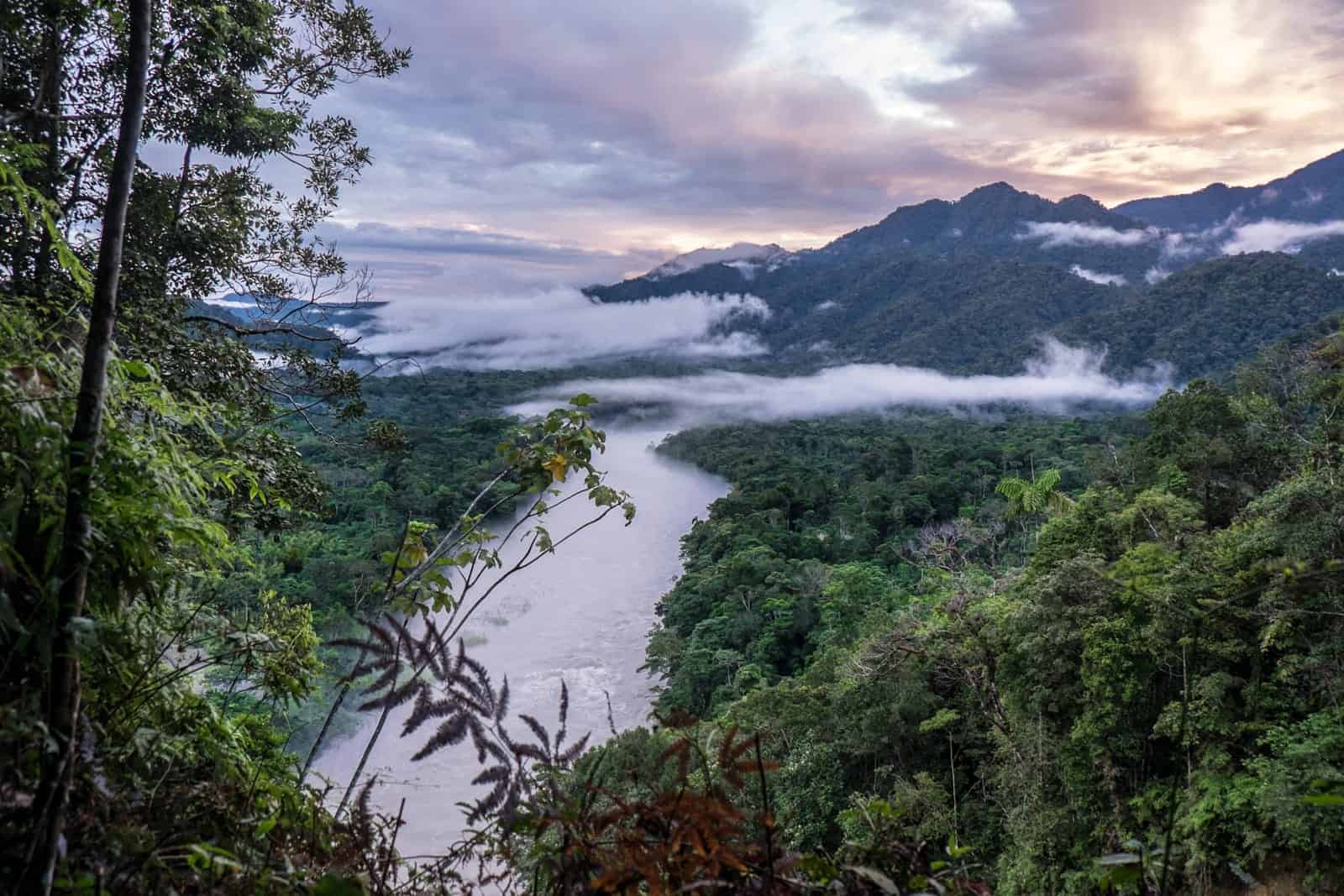
Ecuador Amazon Rainforest Guide – Local Living in the Most Diverse Biosphere on Earth
The size of the Amazon Rainforest is mind-boggling, being one of the most diverse ecosystems in the world, encompassing an area of over 2.5 million miles across nine countries in South America – Bolivia, Brazil, Colombia, Ecuador, Guyana, French Guiana, Peru, and Suriname. This makes it the most important rainforest in the world, spanning around 40% of the entire continent.
With vast biodiversity that is said to cover just under one-tenth of the earth’s landmass, the Amazon holds thousands of different species of animals and plants, beautiful landscapes woven together by rivers, lakes, seemingly infinite swaths of dense rainforest, as well as some of the world’s last remaining indigenous tribes.
According to this extensive list of facts about the Ecuadorian Amazon Rainforest, there are over 1,400 different animal species, including 200 mammals, 121 reptiles and nearly 600 bird species. And that’s not including the 70,000 types of insects and the 1,000 species of trees.
It’s exactly this untouched landscape status, filled with half of the world’s known species, and that so much of it remains completely uninhabited and unknown, that attracts the more curious who want to peer in and try to understand it.
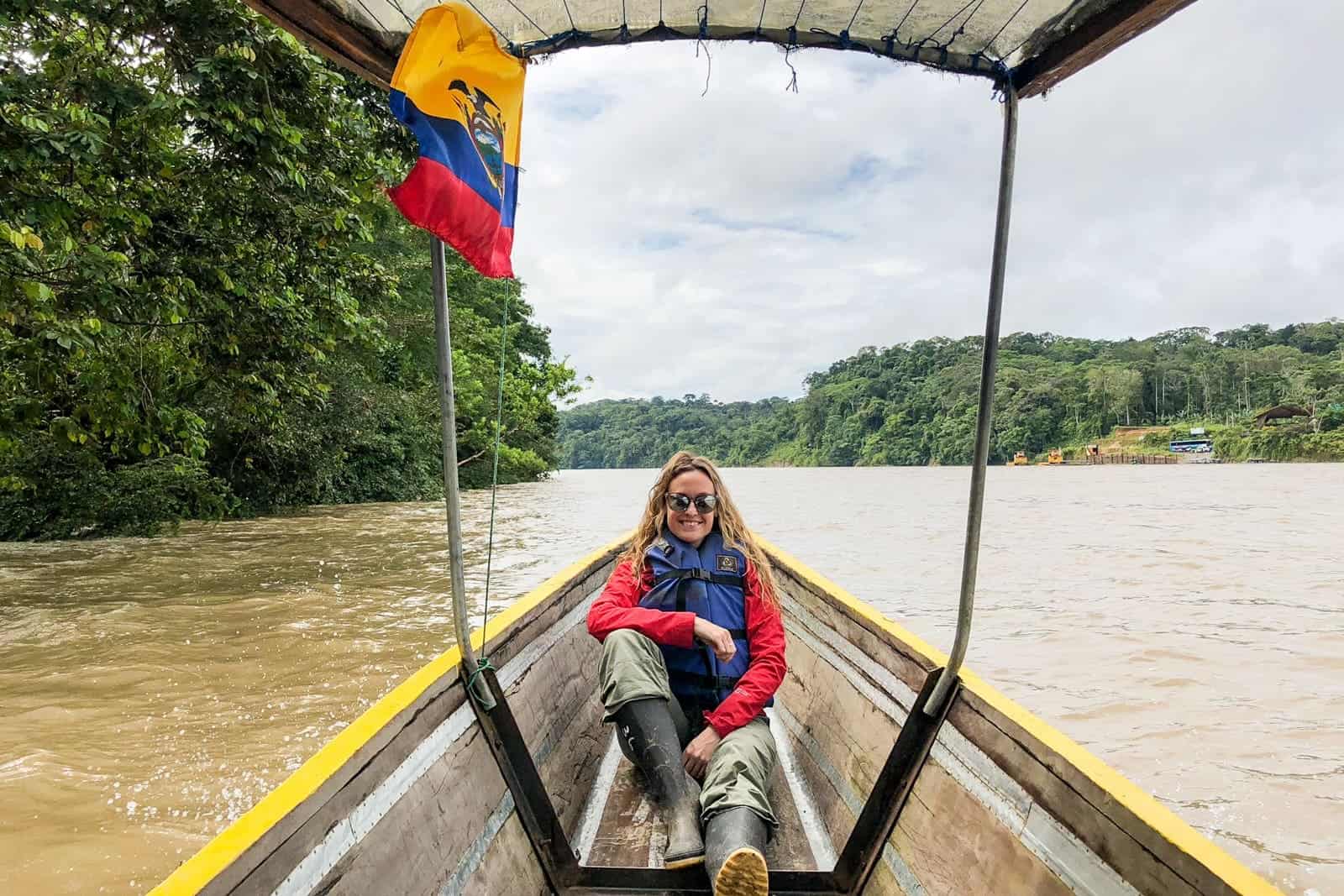
Longboat trip on the Amazon River in Ecuador
Contents
Why go to Ecuador to Visit the Amazon?
Since it’s such an extensive region, it becomes hard to pinpoint which country has the best benefits regarding a trip to the Amazon. With nine different countries sharing a part of the Amazon rainforest, you might think you’ll miss part of the adventure if you only stay in one country. Yet, it’s good to consider choosing a country with plenty of services and regular tours into the Amazon as the best option.
Truly remote parts of the Amazon are either off-limits, impossible to get to, or would simply take multiple days to reach.
Travel to Ecuador is about seeking pristine nature, with the Galapagos or the Amazon Rainforest being the core trips that the budget is allocated to. Quito is simply the landing ground for such wider adventures in the country.
When outsiders visit the Amazon, they often travel to its fringes, where infrastructure and the commodity of lodgings allow, yet it still provides enough off-beat landscape to experience its true density and for a visitor to feel right in the heart of the rainforest. The Ecuador Amazon region is not different in that offering.
That’s because the Amazon Rainforest in Ecuador is home to the most diverse biosphere on earth – Yasuni National Park and Biosphere Reserve. It’s one of four national parks in the Amazon Rainforest in Ecuador, whose UNESCO World Biosphere status makes it a special place for those adventurers who love watching wildlife and learning about nature.
My first trip could have been a long day trip only touching the sides of this eco bowl, but instead, I wanted immersion. Choosing the G Adventures Local Living Ecuador – Amazon Jungle trip, I got to live with a local family for five days and experience the Amazon from those most connected with it.
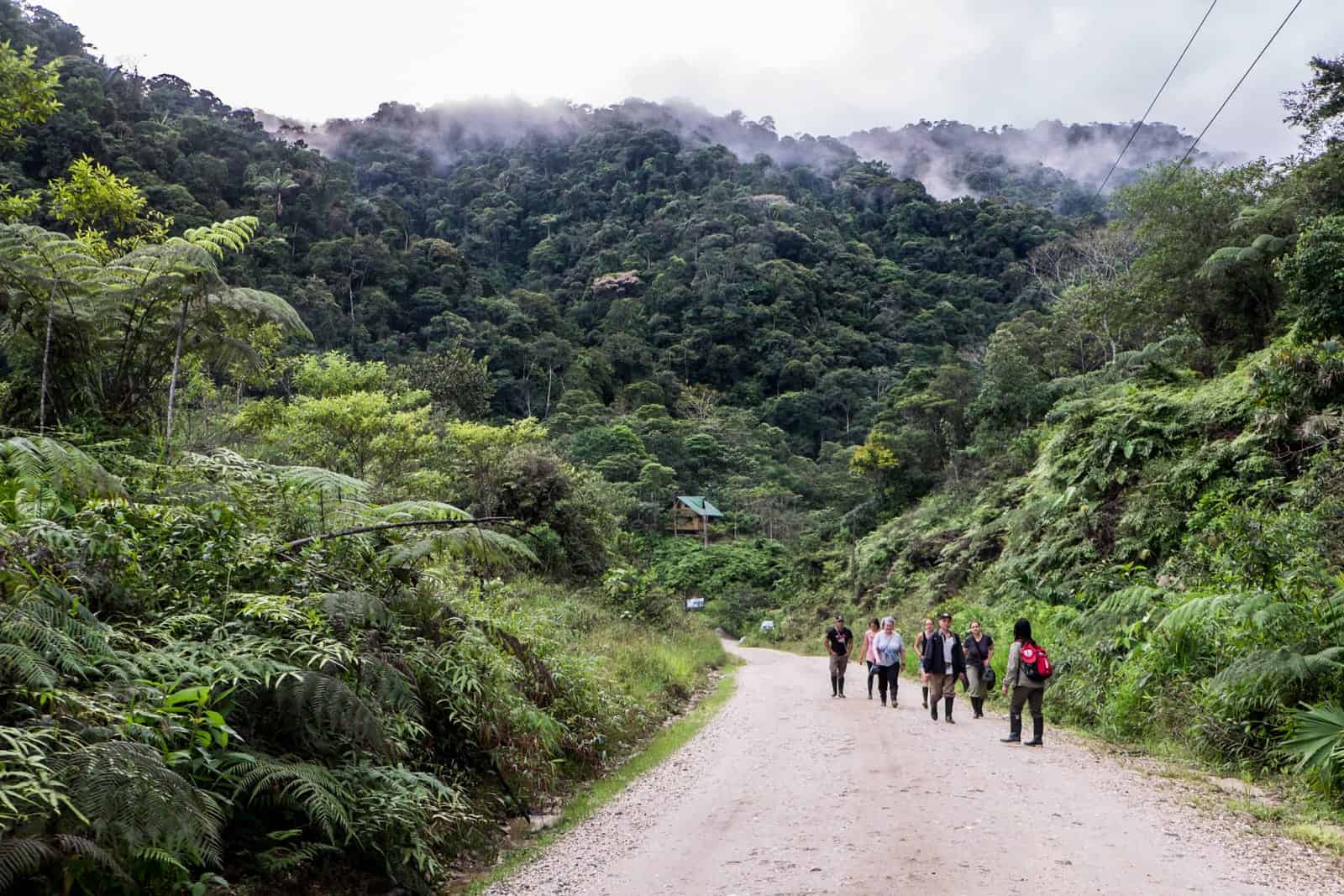
Local Living in the Ecuador Amazon Rainforest
Where to Stay – Local Living in the Amazon Jungle
In the Ecuadorian Amazon, the community of Pimilacha (meaning butterfly in native Quechua) is small but big on welcoming outsiders to understand the way of life here. There are around 25 families, with two working in the tourism industry to host visitors.
The family I lived with has been working with G Adventures for 25 years. In fact, the company’s first tour was to this very place after founder Bruce Poon Tip visited the head of the household and Sharman, Delfin and saw the potential in bringing travellers and communities together for the greater good.
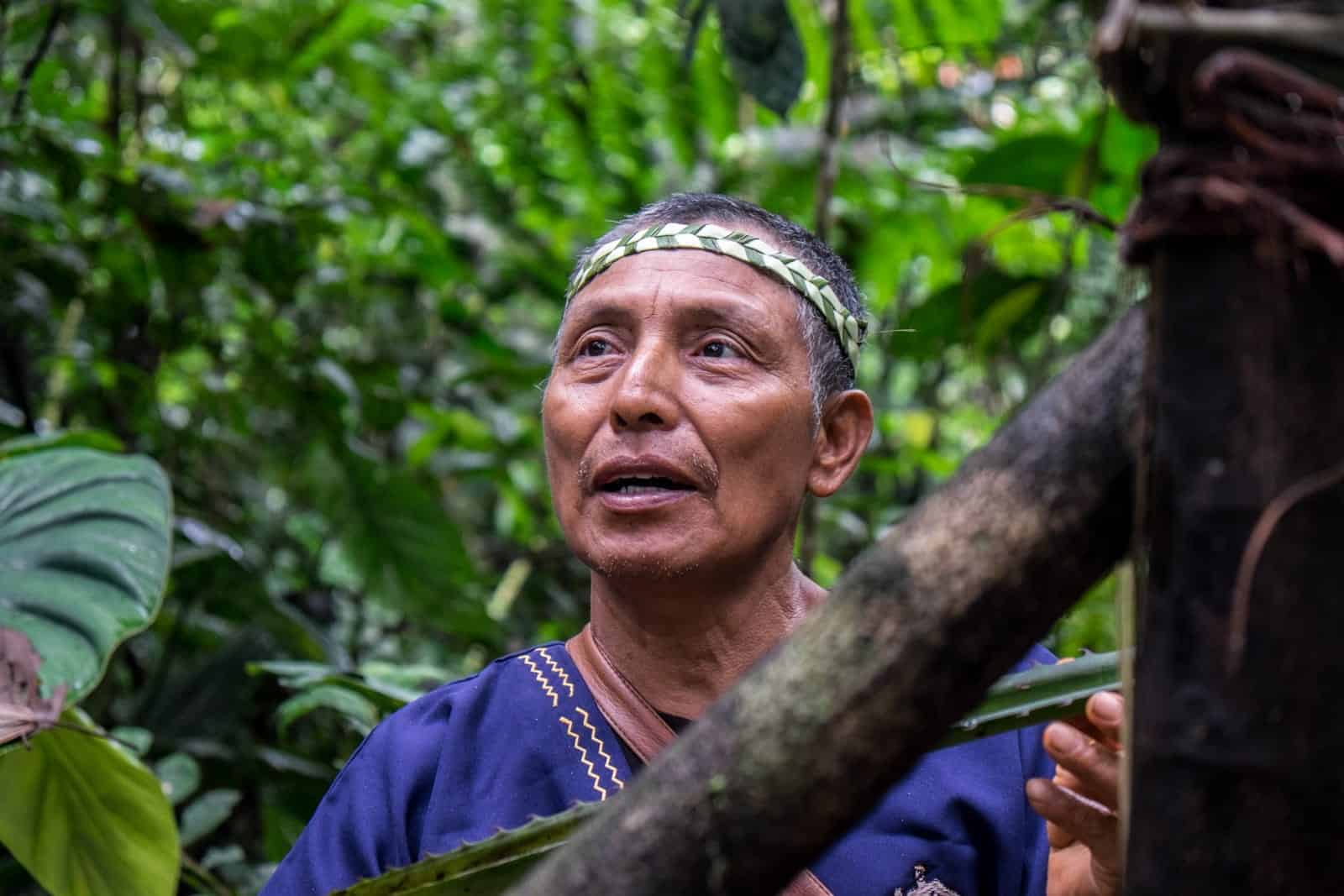
Exploring with Delfin
Quechua culture and traditions are kept alive, communities continue to flourish, and travellers are provided with a unique experience at a local level in an Amazon lodge, in a more remote destination. All the good of travel, without the harmful social impact.
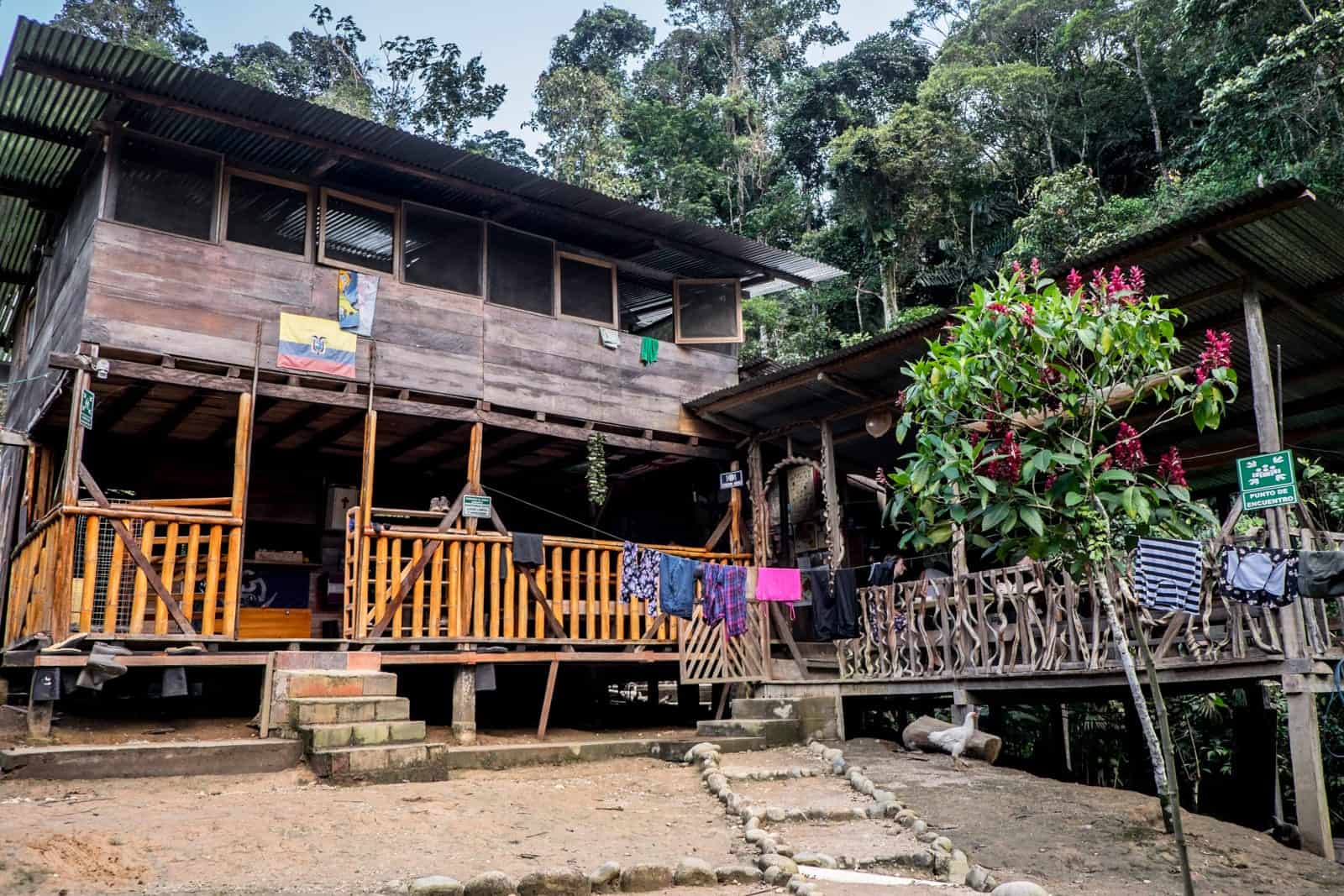
Our local house in the Ecuador Amazon Rainforest
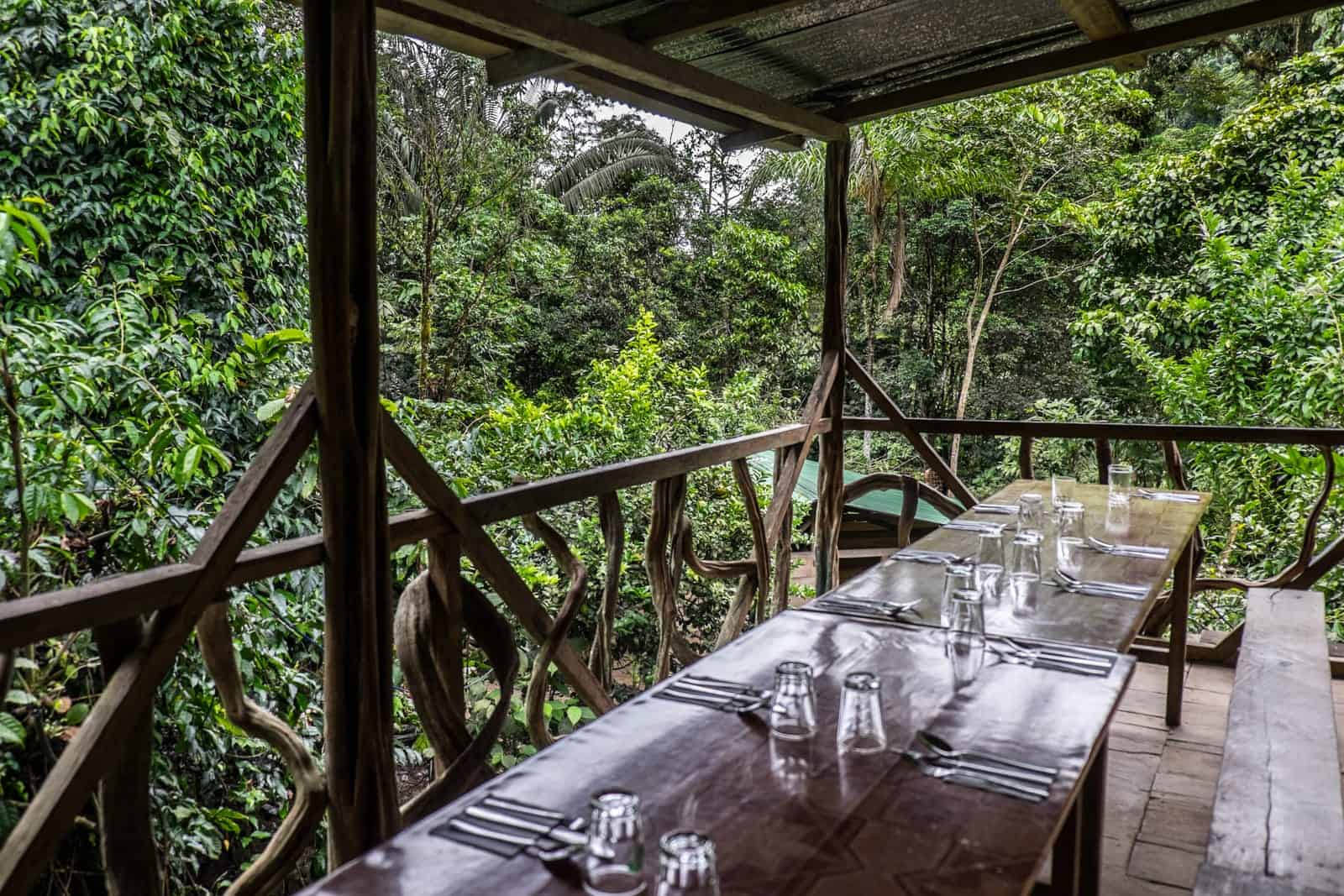
The Ecuador Amazon Lodge for travellers
The family members are all involved in tourism, especially the two sons. Other family members live in the city of Tena, as what often happens when the populations disperse and later generations leave to go to high schools and universities that do not exist out in the jungle hinterland.
The main family house is where you’ll eat and spend the evenings relaxing, with the group residing in the secondary building right next to it in what are predominately twin rooms. Each day we were presented with a delicious breakfast, lunch and dinner, cooked by the mother and daughter, which included native products like plantain and yucca – much needed fuel after a day spent exploring.
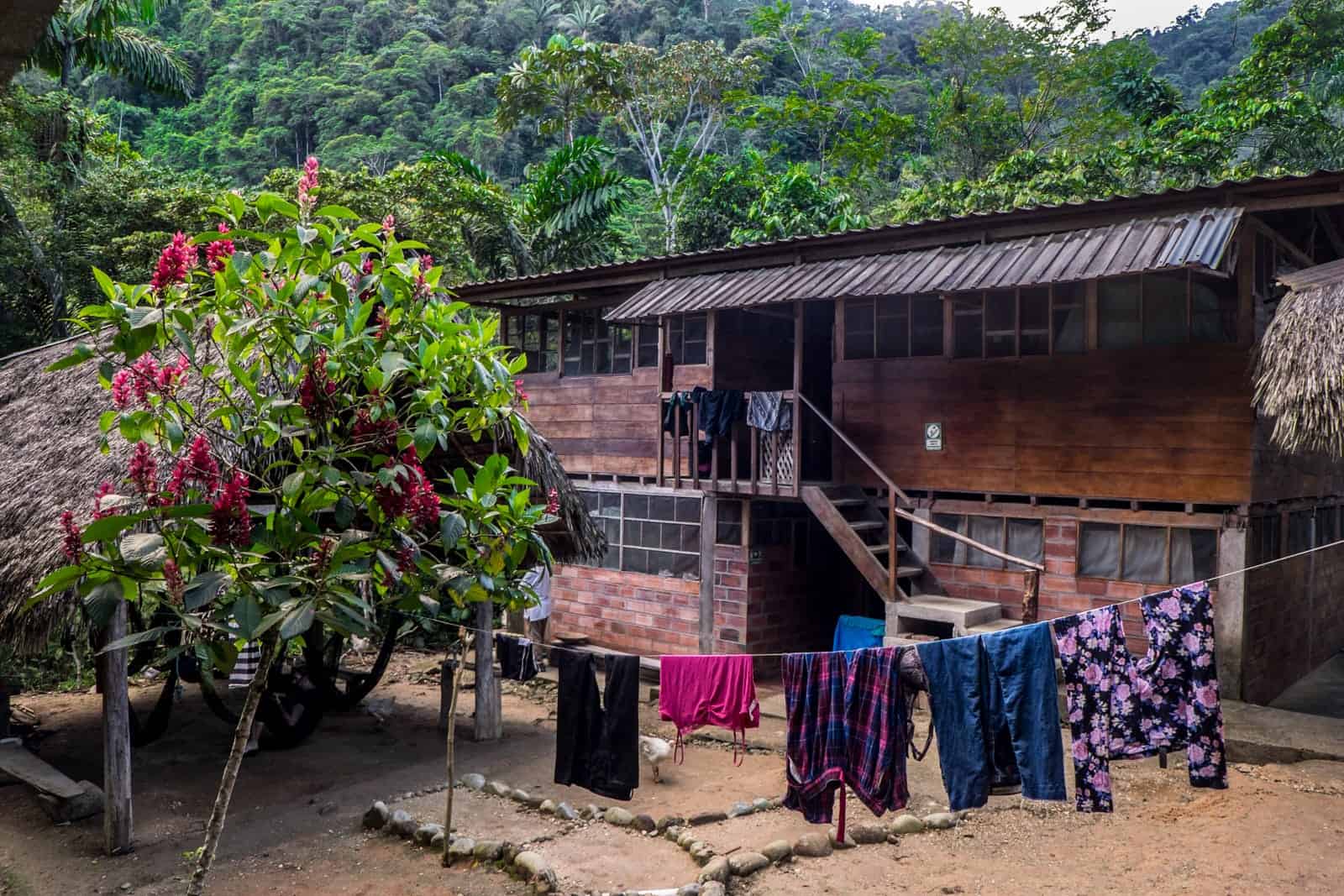
Typical Ecuador Amazon lodge in the jungle
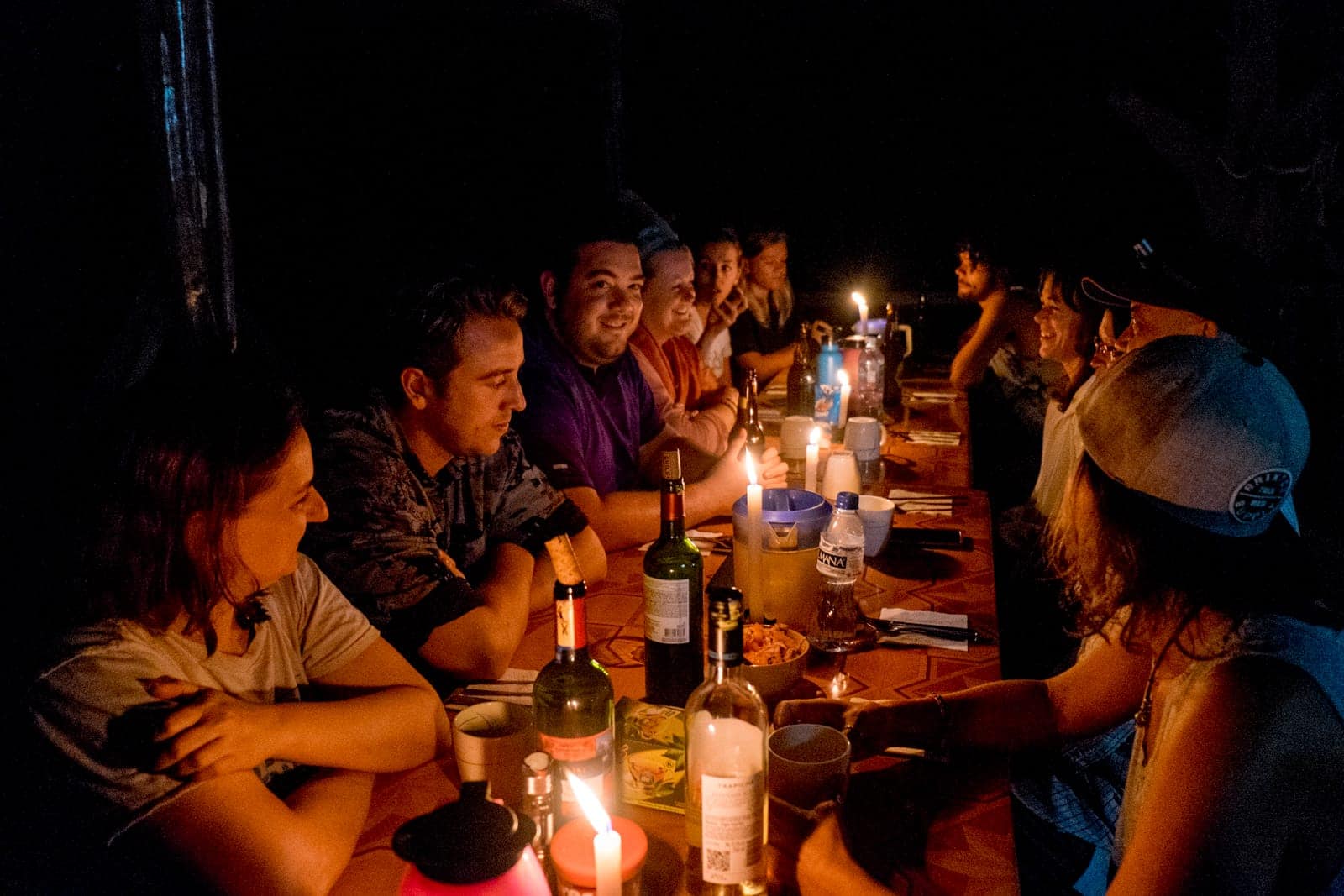
Nights spent in the Ecuador Amazon by candlelight.
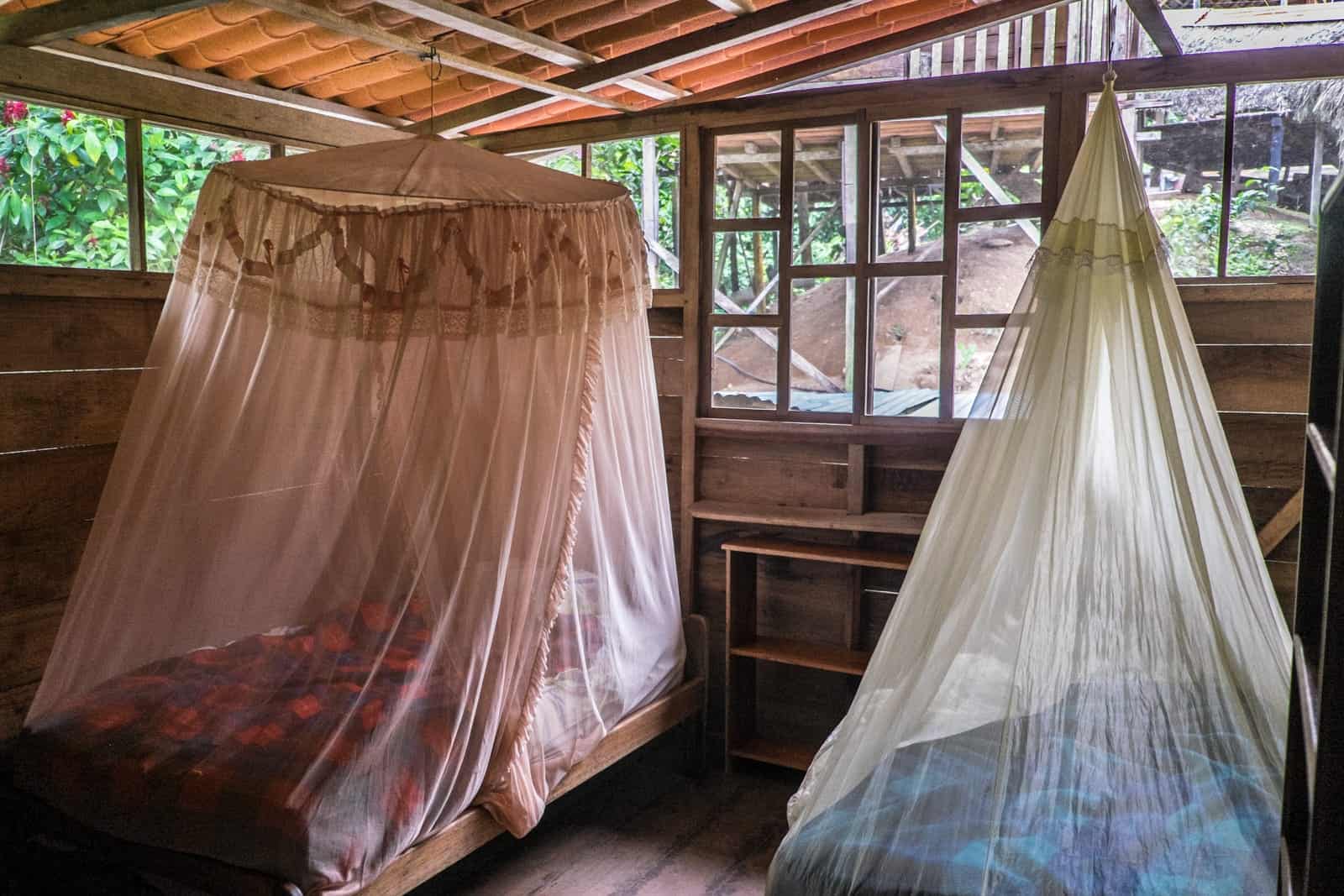
Our Amazon lodge bedroom
You quickly get to learn about life in the Amazon jungle. Each day we got to interact with the family, with the two sons and Delfin being the leaders in exploration, armed with a machete and a lot of knowledge.
Jungle bush walks and the education of our surroundings became a daily ritual, with lessons in how to use a blowgun, coffee and chocolate making sessions being an added cultural extra. We were even taught how to prepare and cook grubs before daring one another to take this culinary rite of passage.
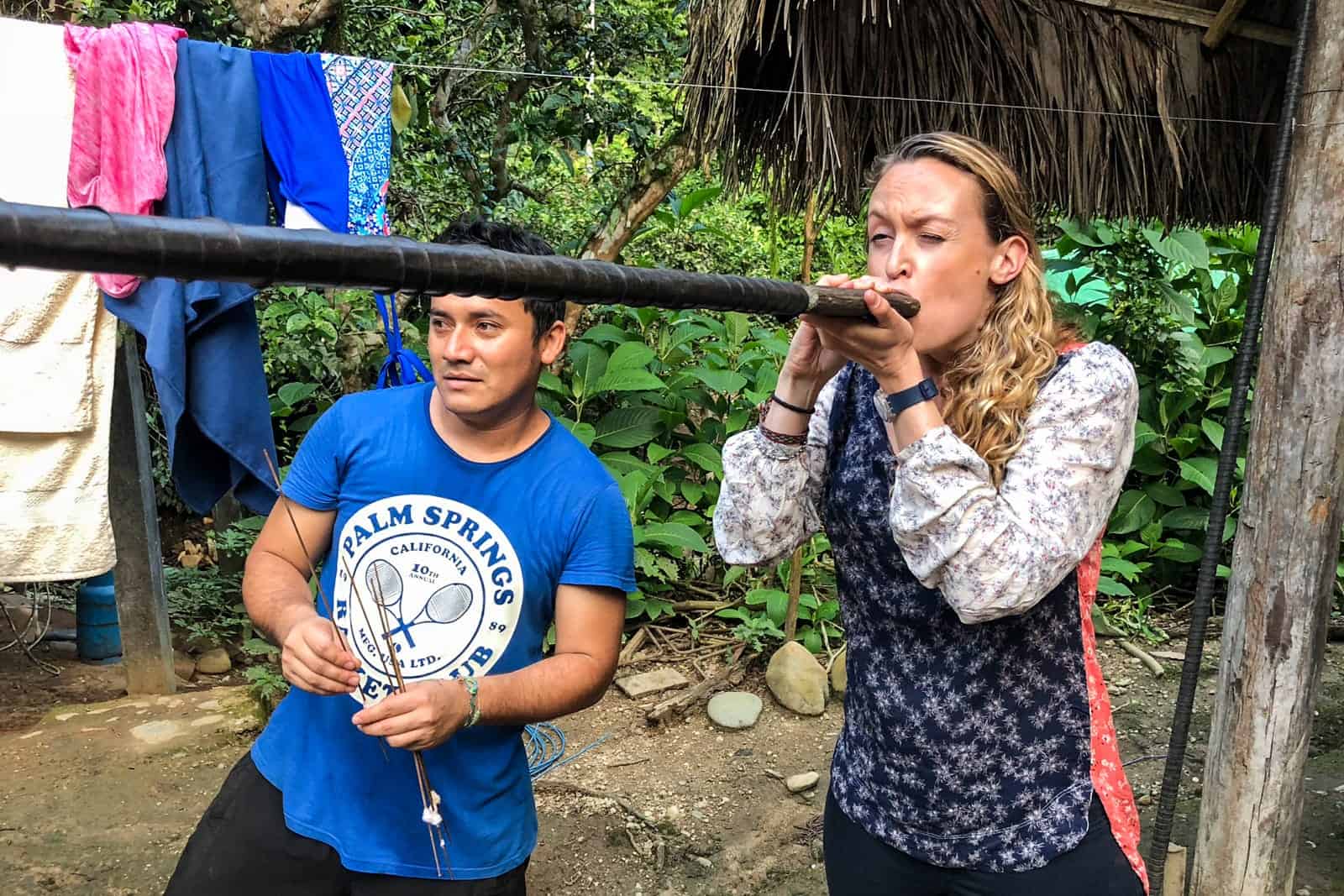
Learning how to use a blowgun.
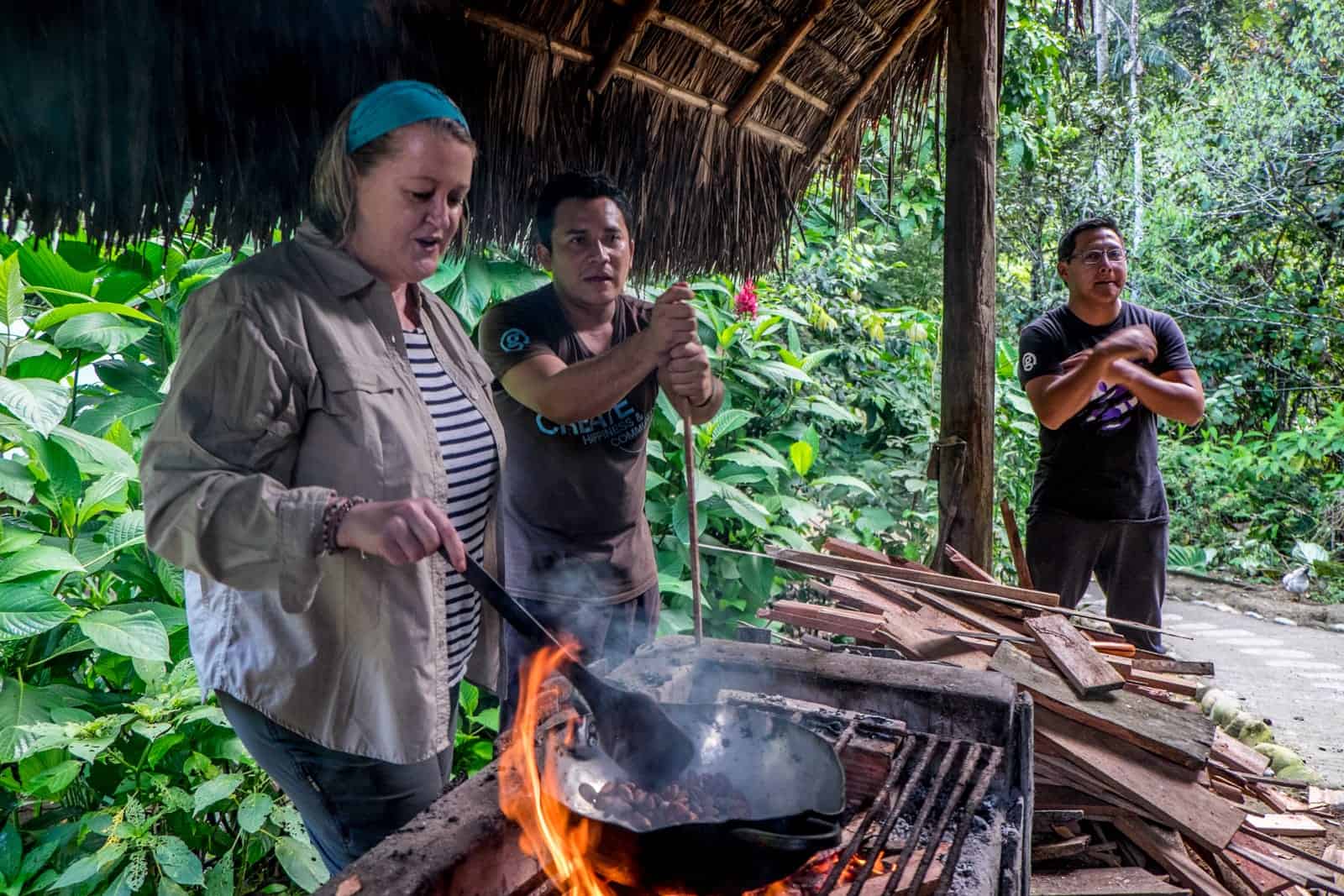
Ecuadorian chocolate making in Amazon jungle.
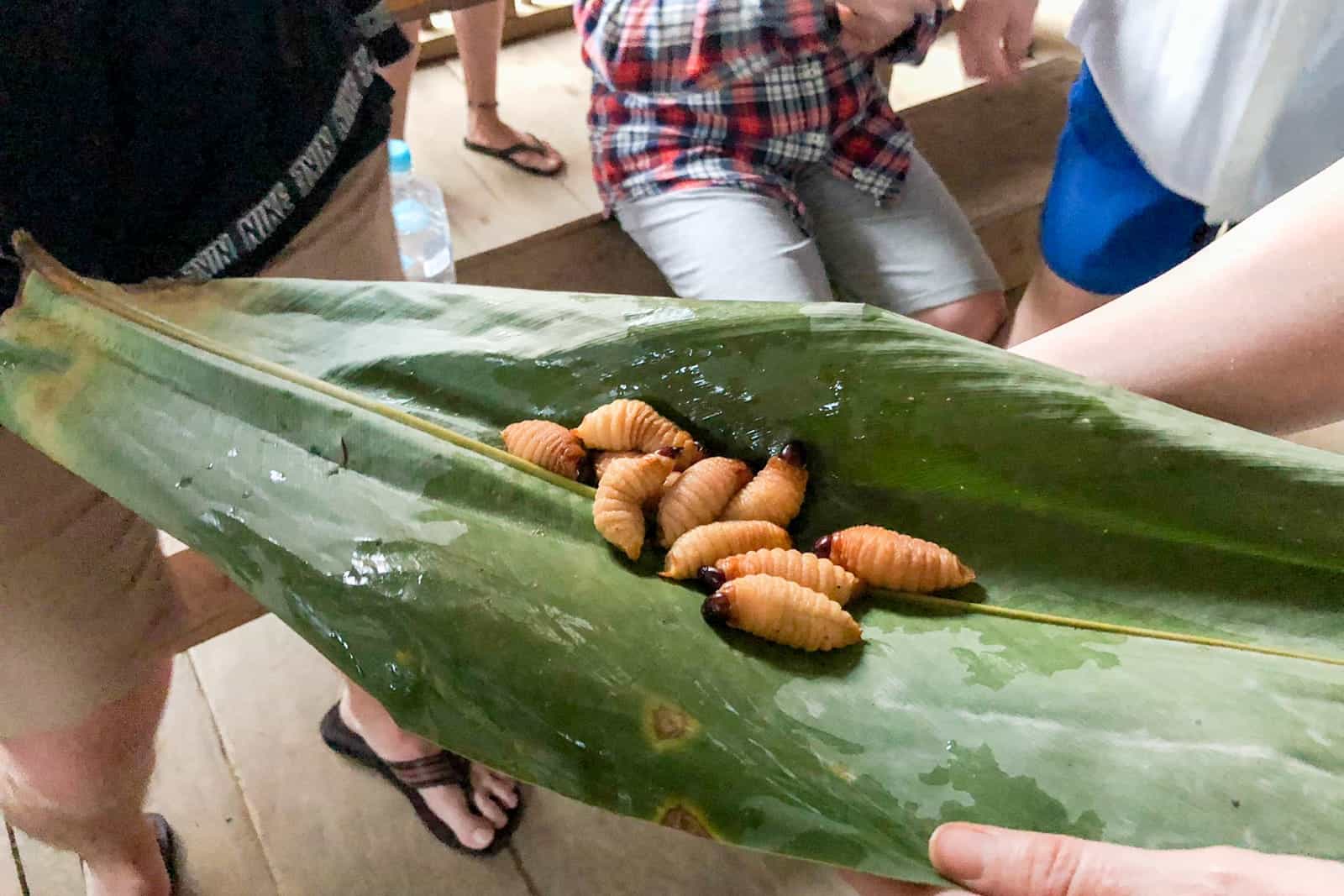
Who dares to try the bush grubs?
The mother taught how us to make Chicha, a typical practice where the women of the household chew on yucca before spitting it out, kneading it and letting it ferment overnight. Surprisingly, the taste of this particular form of natural jungle alcohol isn’t so bad, and of course, there is a non-fermented version available for visitors.
Browse dates and book your Ecuador Amazon homestay here.
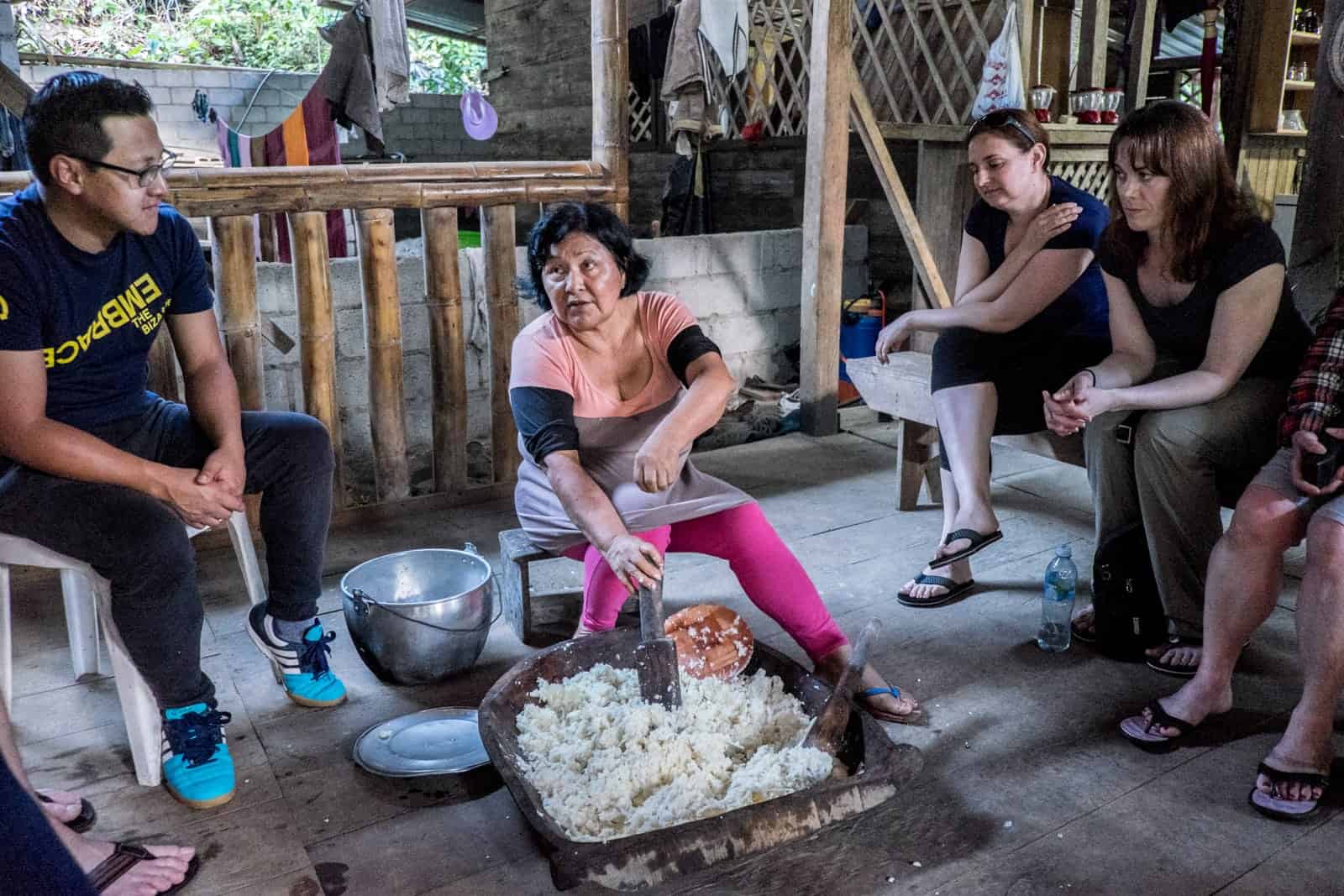
Making chica with travellers in Ecuadorian Amazon.
Culture, Adventure, and Nature in the Ecuador Amazon Rainforest
Amazon People and Culture
The Amazon Rainforest summons up images of remote tribes. Ecuador has nine indigenous communities that live in the rainforest and two or three tribes that choose to live in isolation, living as their ancestors did thousands of years ago. This is not our place to disrupt a social hierarchy and remote way of life.
Many of these tribes are deeper within the Amazon, where it would take days for those who live on its fringes to reach them. If you want to experience and learn about the indigenous tribes of the Amazon, you can from the locals you live with, since core parts of the culture and traditions have been passed on, even if these communities now live differently.
Jungle walks teach you about basic survival, hunting and the medicinal properties of plants; daily life teaches you about the coexistence with nature and the respect of the rainforest’s other (animal) inhabitants; Shamanic culture teaches you about how humans can harness the power of nature and go back to our basic instincts and tranquillity.
Shamanic Practice in Ecuador and the Amazon Rainforest
You might get to experience the Ecuadorian Amazon Shamanic culture firsthand, learning how they blend medicinal herbs, nature, and their faith in spirits to heal and lead their tribes. If you’re interested in this mysterious healing culture, there are excursions that can take you to traditional villages and take part in this fantastic experience.
At my local family home, we were given an introduction to the shamanic practice one evening by candlelight. We witnessed songs and chants, the concept of oneness with nature and how part of this tied in with rituals and ceremonies such as weddings.
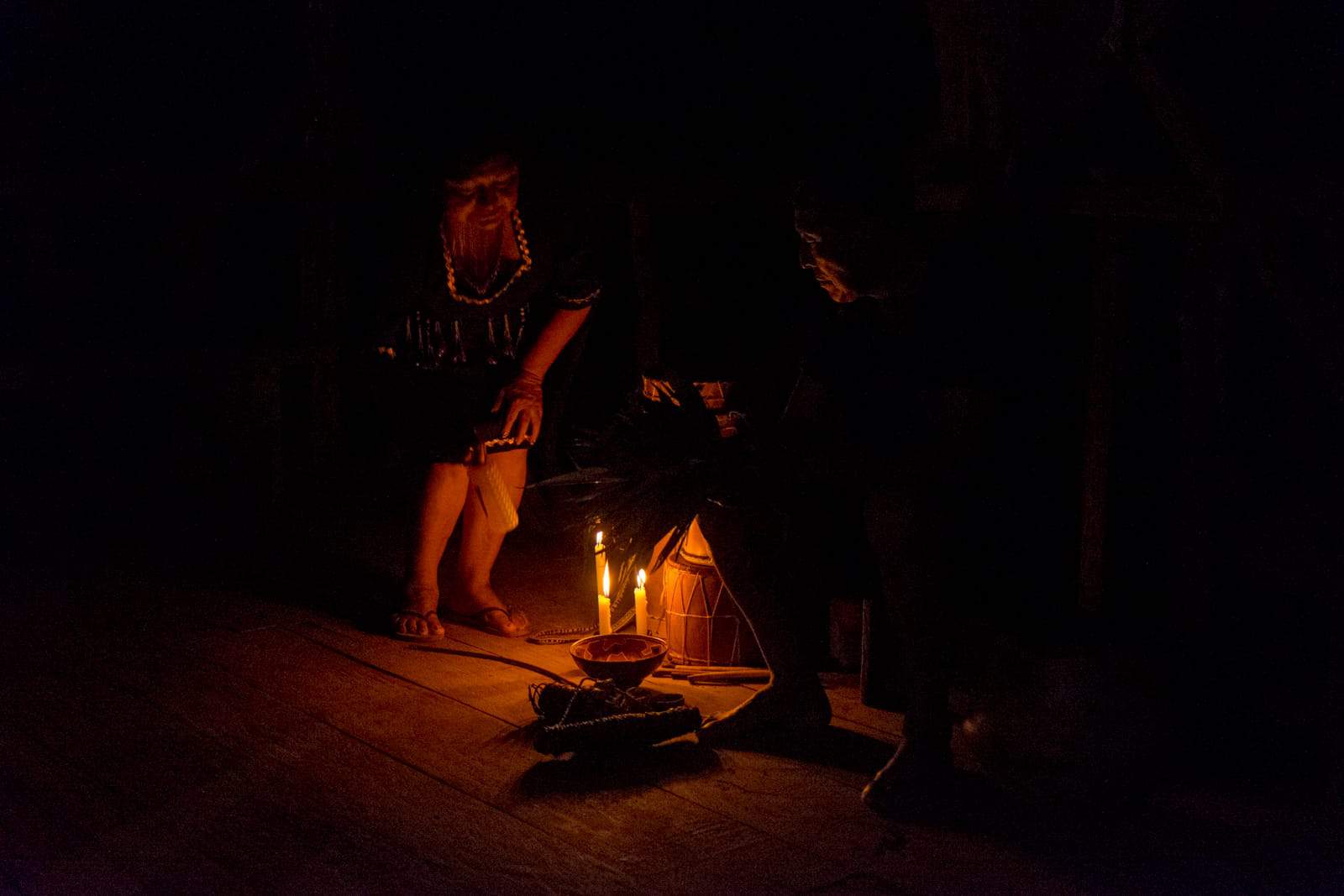
Understanding Sharman practice in the Ecuador Amazon.
I was lucky in that I got to have a one-on-one experience with Delfin; a curiosity in a form of healing that goes to the very core of what we are and what a lot of us have lost touch with – nature.
In an empty hut, I sat on a wooden floor with my back facing Delfin. Spatters of cleaning oils rapidly flew through the air as they were lightly spat on me, followed by the deep breaths of the Sharman who then continued with chanting. As he chanted he used a small batch of leaves to tap me lightly on the head and in a rhythm. The first taps were on my head before making a circular motion from the head around the shoulders.
He sang. His voice was the only one I heard in the stillness of the Amazon, overriding the nature surrounding us. His song was in unison with the movement of the leaves, before placing his mouth to my head, breathing in with a swift sucking motion. Together, this is all a part of a process used to draw out and read energy via the head.
When Delfin had his reading, he closed the ceremony by spitting more cleaning oil before pouring some into my hands, which I was asked to smell with long-drawn breaths, rub on my face and sweep through my hair. I was told of my intense stress levels, and how to breathe deeply every morning to take energy from the sun.
I was told that in order to see more intensely, one would have to go through the rituals of using Ayahuasca, although that is a controversial issue since many travellers have been lured to unregulated Ayahuasca retreats with often dangerous consequences. The practice of Ayahuasca with tourists is illegal in the Amazon of Ecuador.
Amazon Adventure Activities
If you’re looking for the thrill of adventure and exploring the nature of the rainforest, the Amazon has plenty of activities. Whether it’s kayaking in the streams of the Amazon River, wildlife watching or trekking the jungle by foot with a guide, you’ll have an experience of nature at its most raw.
Our days were spent walking through the jungle to the sound of monkeys who followed our every move out to viewpoints across the famed Amazon River, or learning about medicinal plants and survival with knowledge Delfin continues from his forefathers.
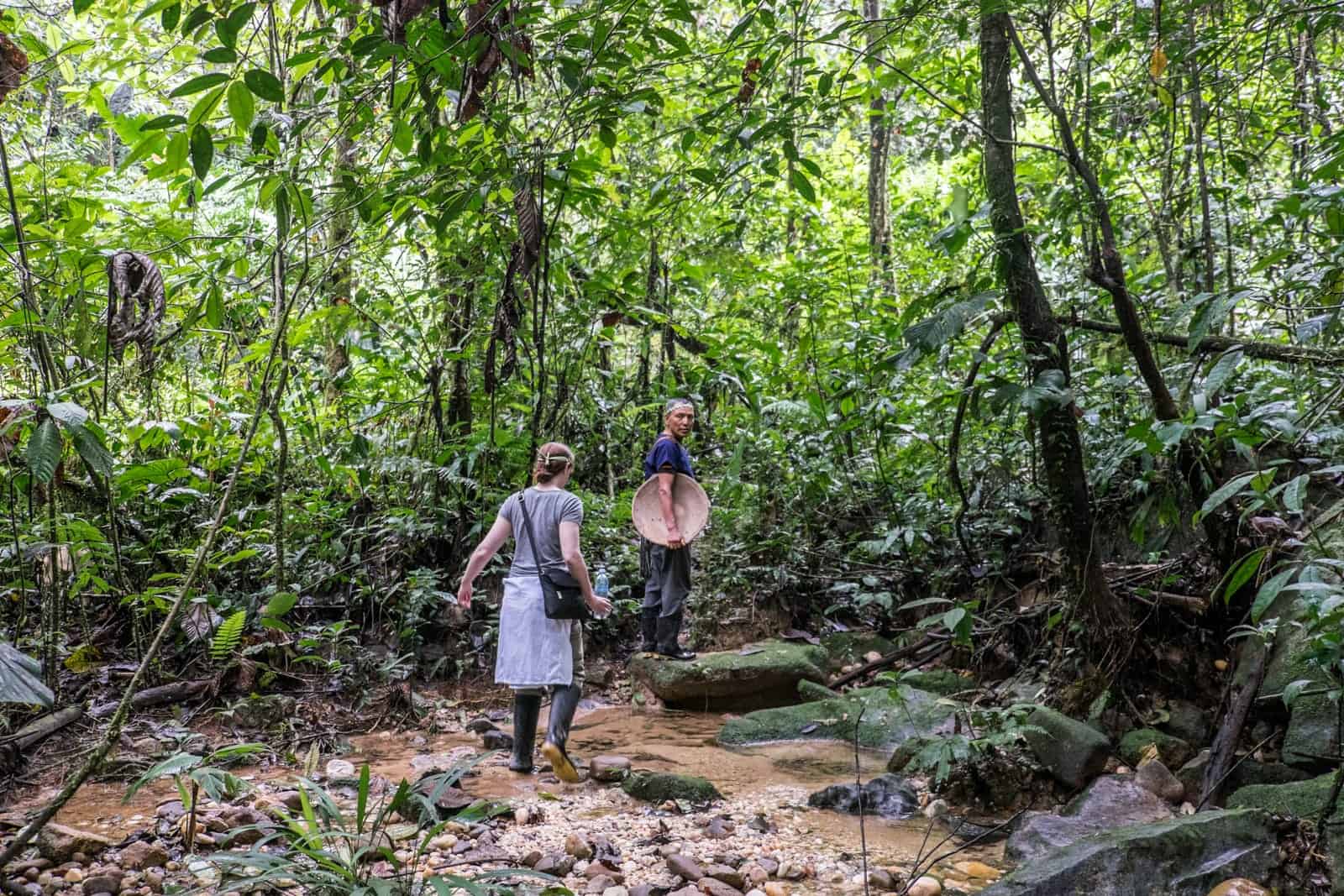
Jungle trekking in the Ecuador Amazon Rainforest
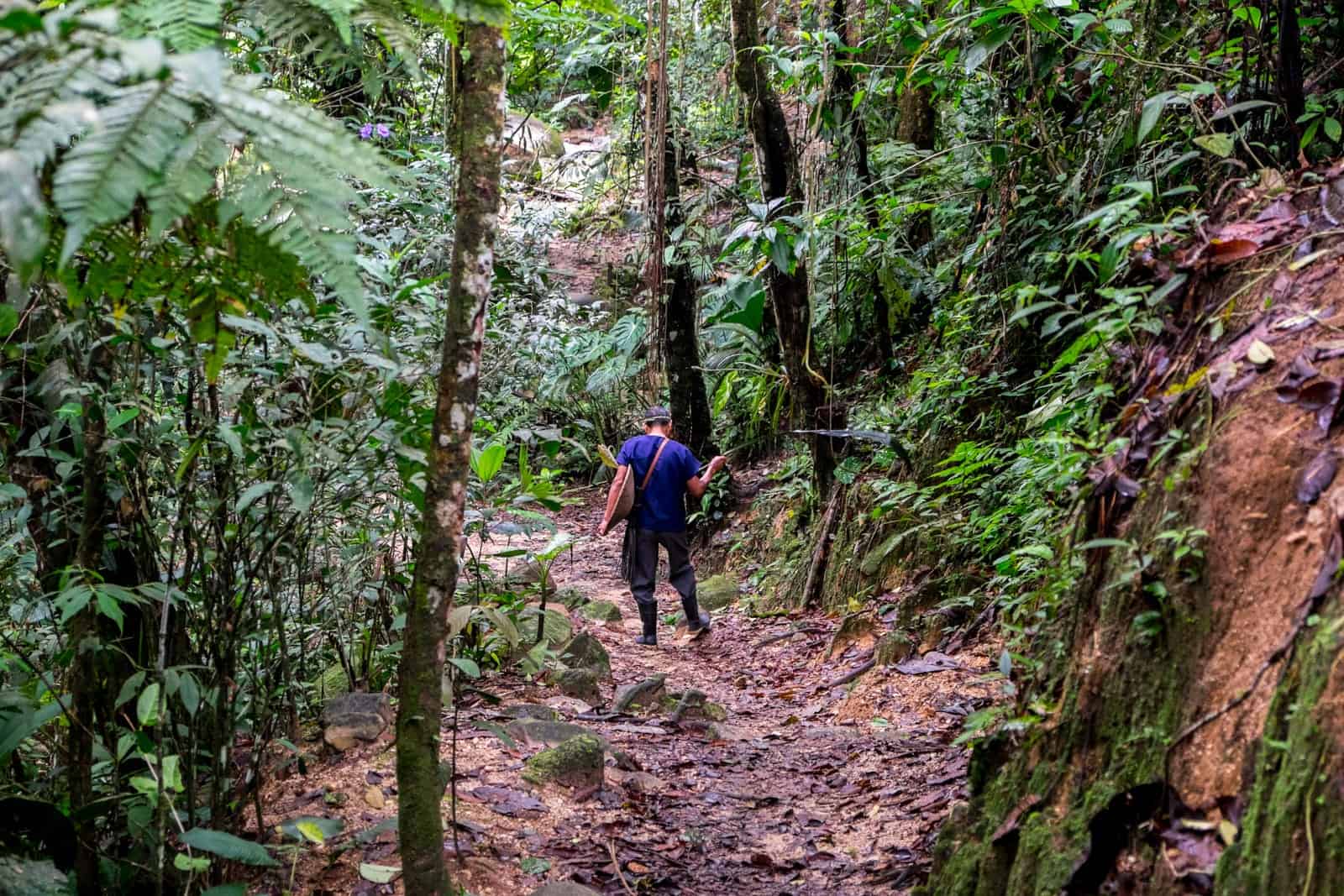
Deep into the jungle.
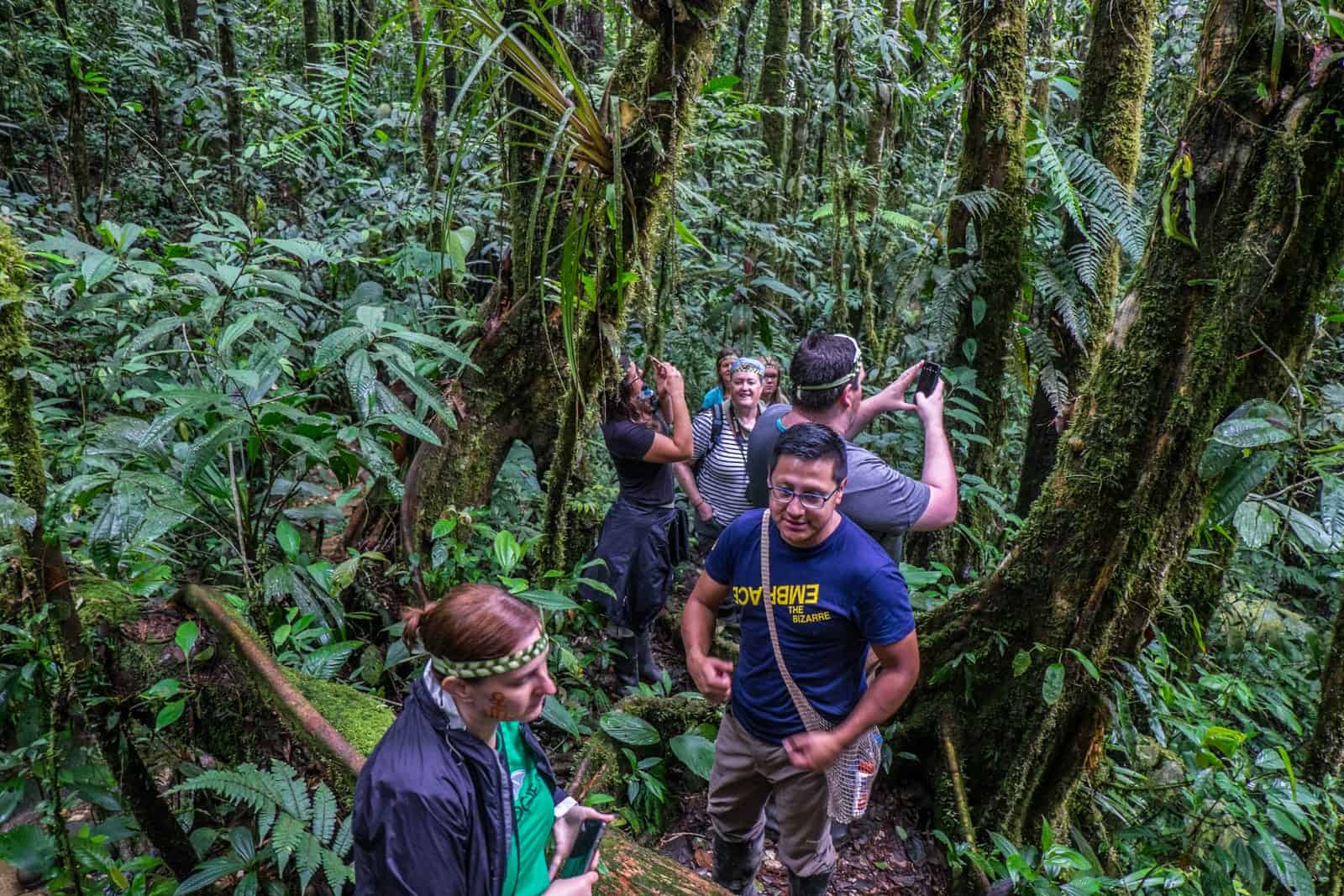
Jungle treks in Ecuador are best experienced via a small group tour with a local guiding the way.
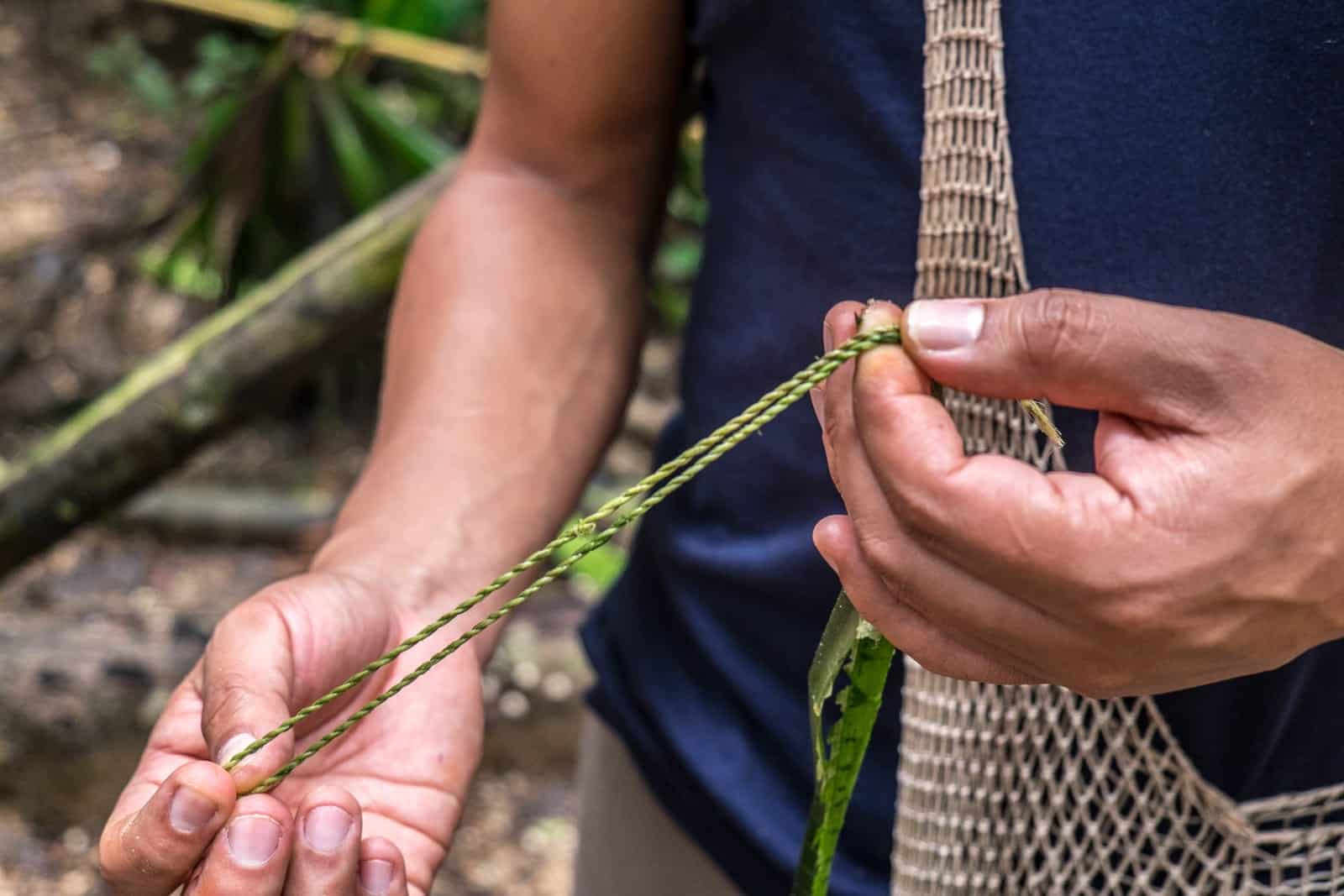
Plant rope – one of the essential survival tools in the Rainforest.
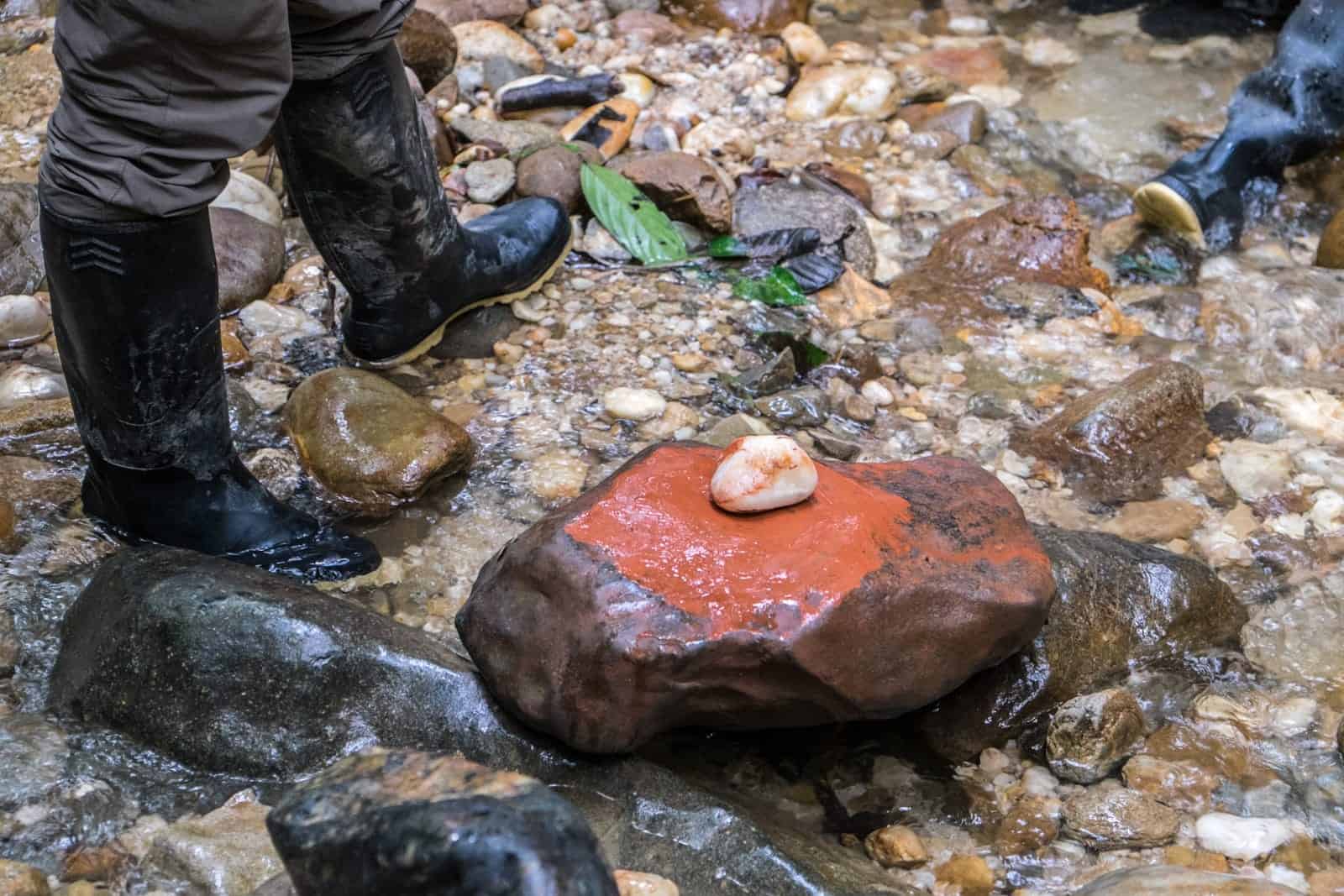
Making natural paints from stones in the Amazon
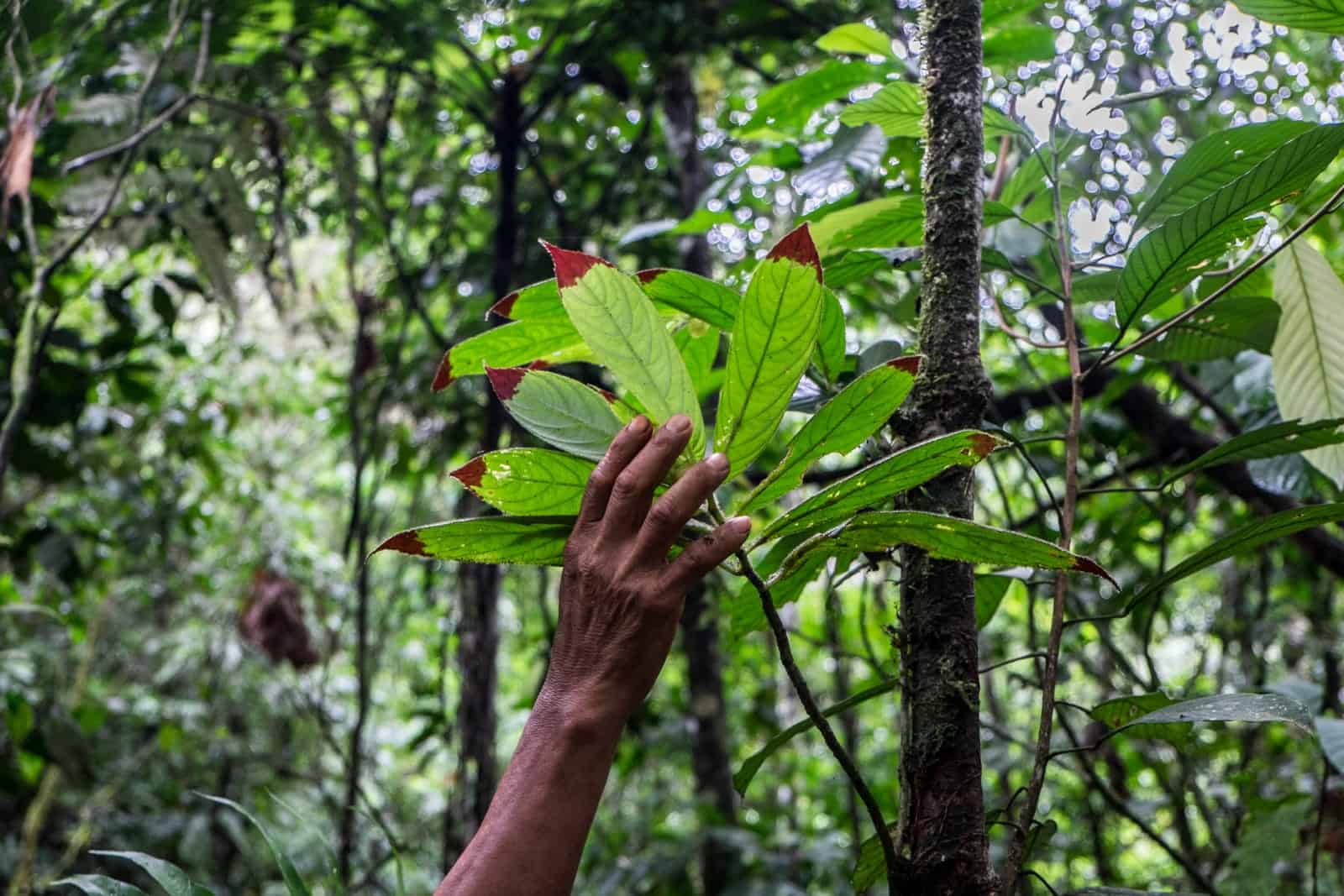
Finding unique Rainforest plant species.
We bathed in the stream behind our house and covered our faces with the natural clay found in the foundations of the rich jungle beds and trekked to jungle waterfalls. We rode carefree in the backs of trucks to go and swim in lagoons and boarded river longboats in search of wildlife and a glimpse into the vast depths of the Amazon Rainforest.
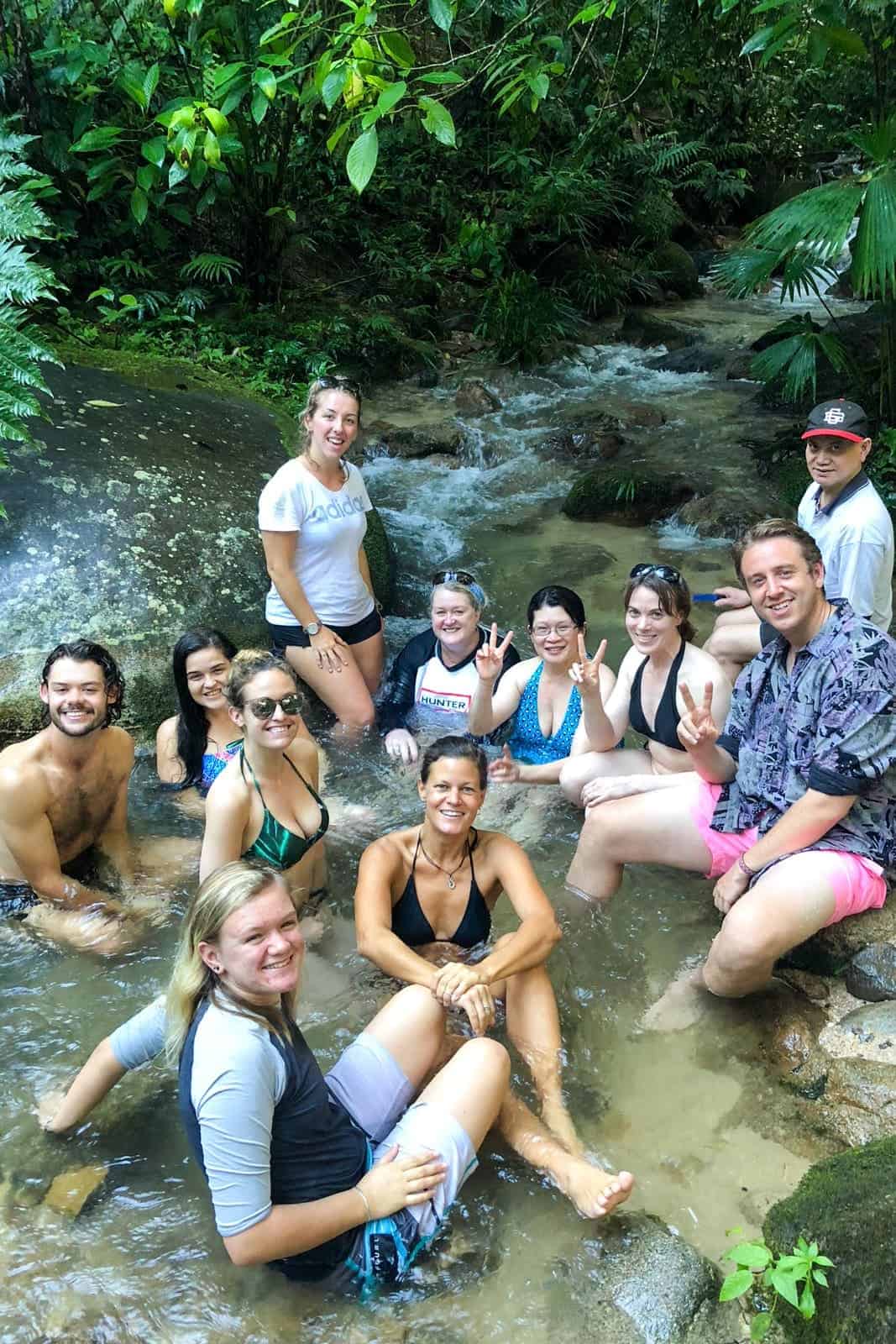
Jungle stream bathing in Ecuador Amazon.
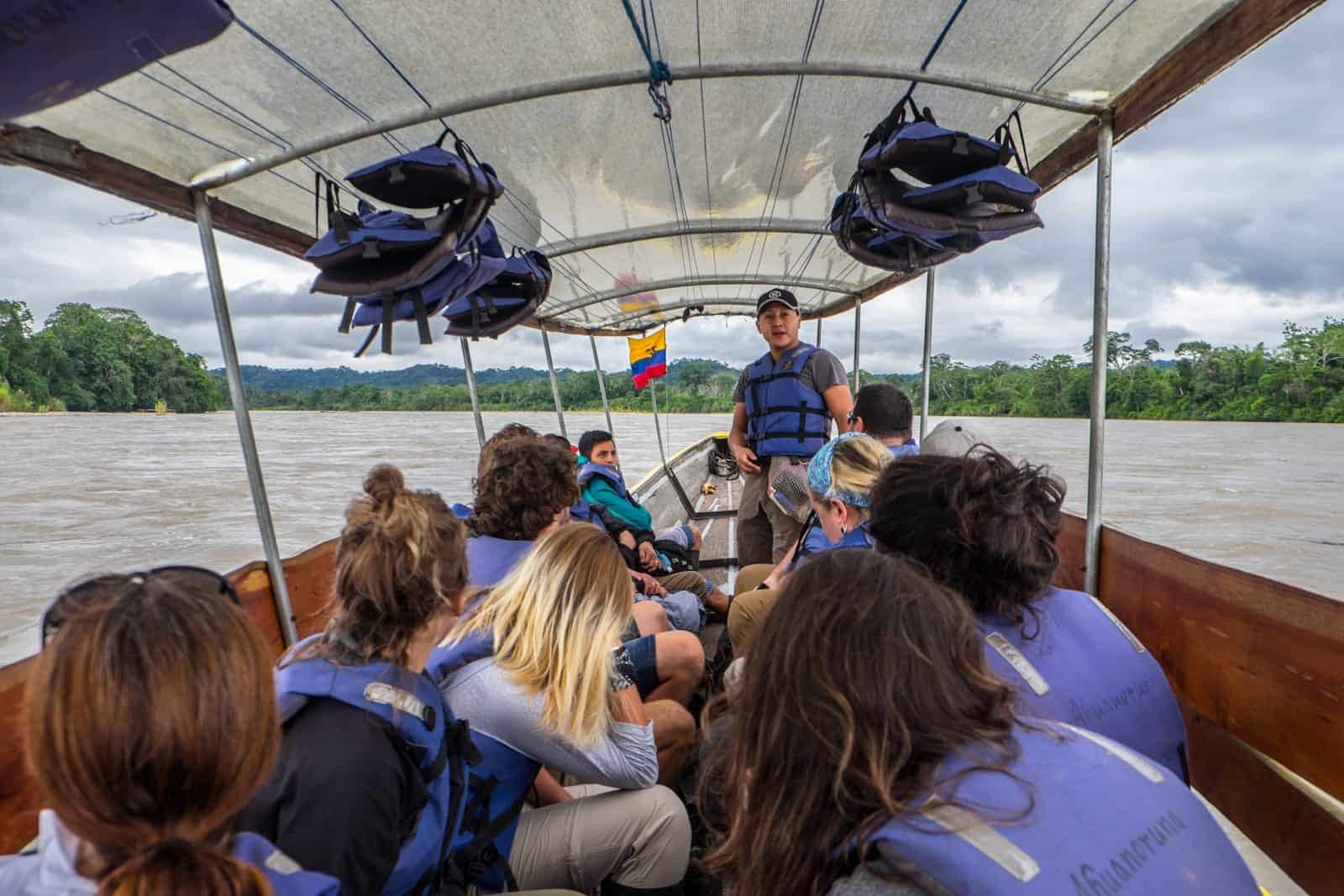
Longboat ride through the Amazon Rainforest waterways is a rite of passage.
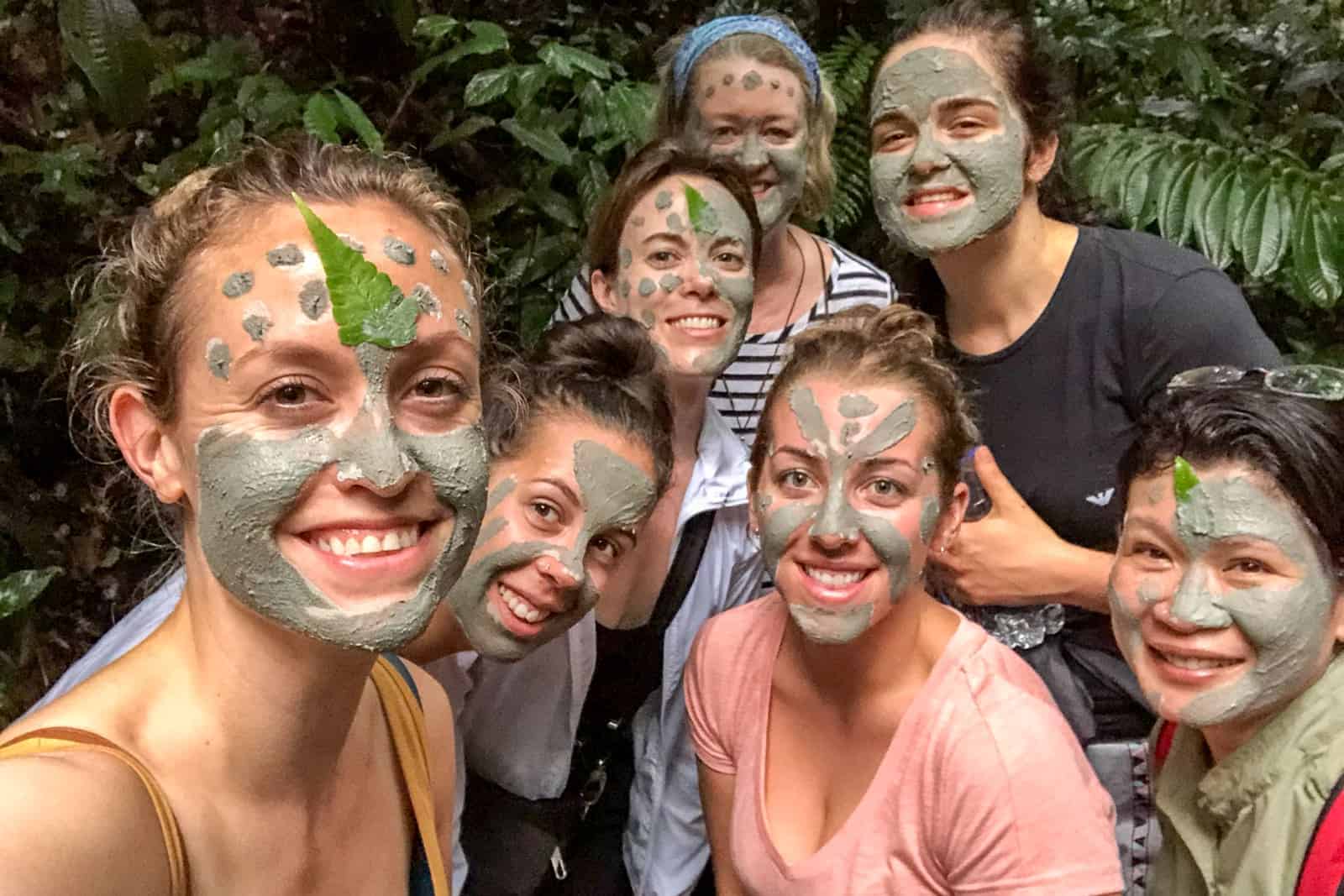
Natural jungle clay face masks.
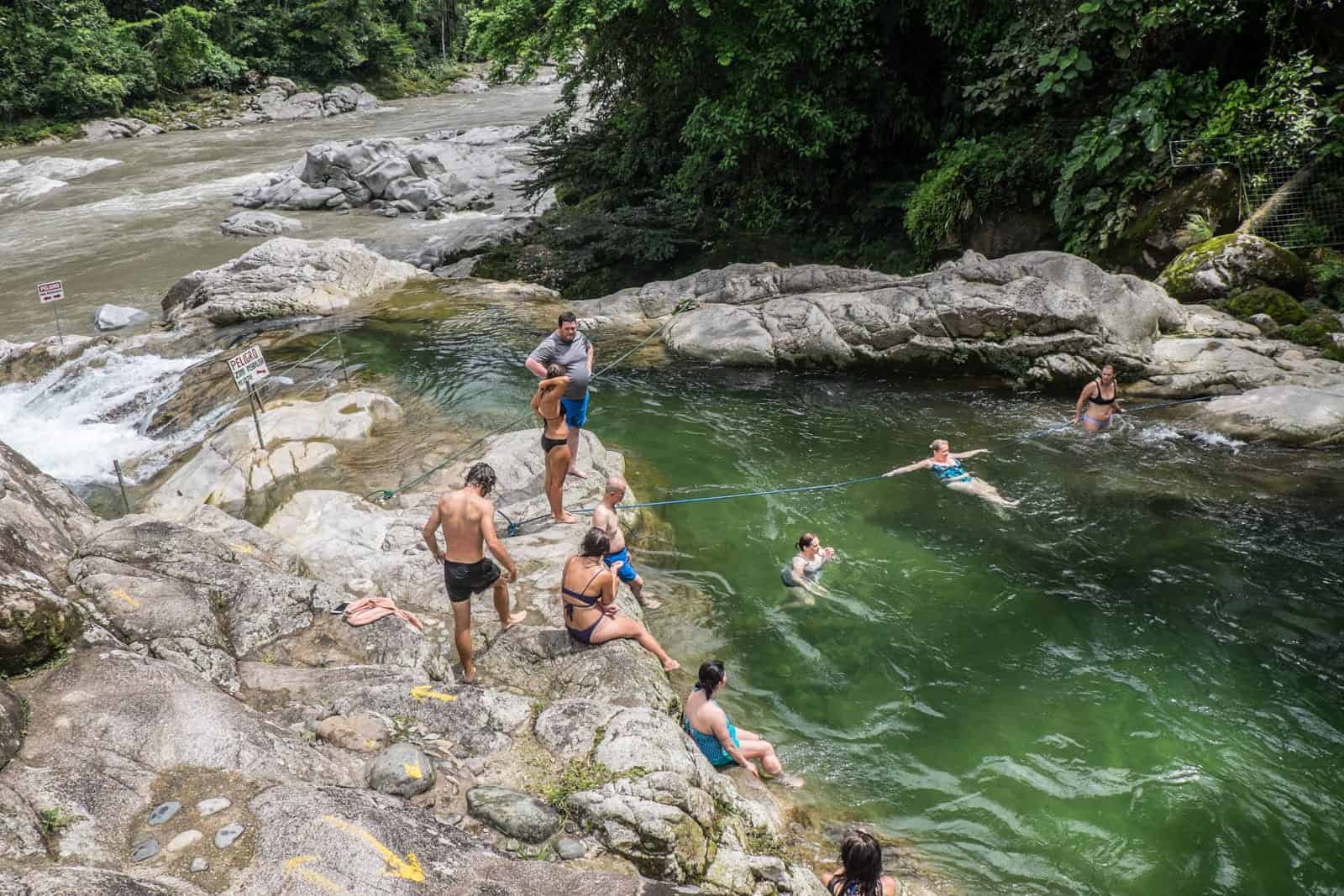
Swim in an Amazon lagoon
On our final day, we went water rafting on the Jatunyacu River – a faster flowing tributary that commanded a lot of energy. Even after water rafting in Europe and Asia, this grade three level put us all through our paces. It was an extra excursion offered as part of our overall tour.
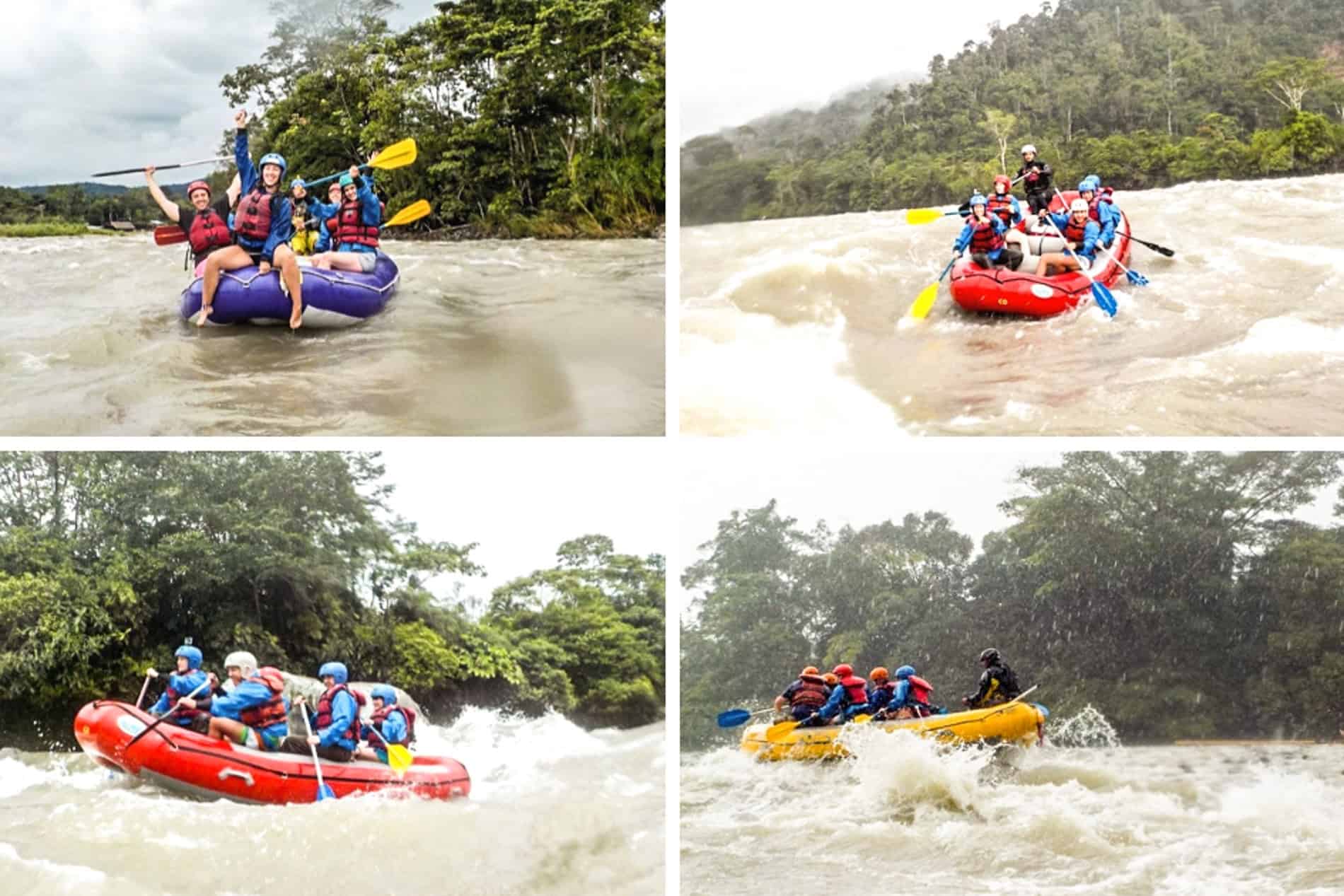
Go water rafting in the Amazon of Ecuador.
Rafts were flipped and tipped, ours hit a giant rock, and many of us embraced the waters, all the while realising we were mere specks of life in a place of such raw earth significance.Really, we all wanted to get in – because we were deep within a trail of the mighty Amazon River. This was a once in a lifetime race against nature, a fast-flowing picture book of the swathes of Rainforest we passed on either side and a chance to delve into the waters of one of the world’s most incredible eco-systems.
Ecosystem and Wildlife – Enjoying the Rainforest
Although Ecuador has access to one the smallest pieces of the Amazon Rainforest, it has the most diverse ecosystem of them all, with a wealth of plants, animals, and sights to see in Ecuador’s national parks and reserves.
Despite limited infrastructure certain parts of the Amazon are accessible and open for exploration at the hands of local guides who know the waters, nature and the seasons. One of the main ways we got to learn about the wildlife in the Ecuador Amazon wasn’t just from observing on jungle walks or lingering silently on the longboat watching the rustling of the leaves in front of us, but by visiting the Animal Rehabilitation Centre.
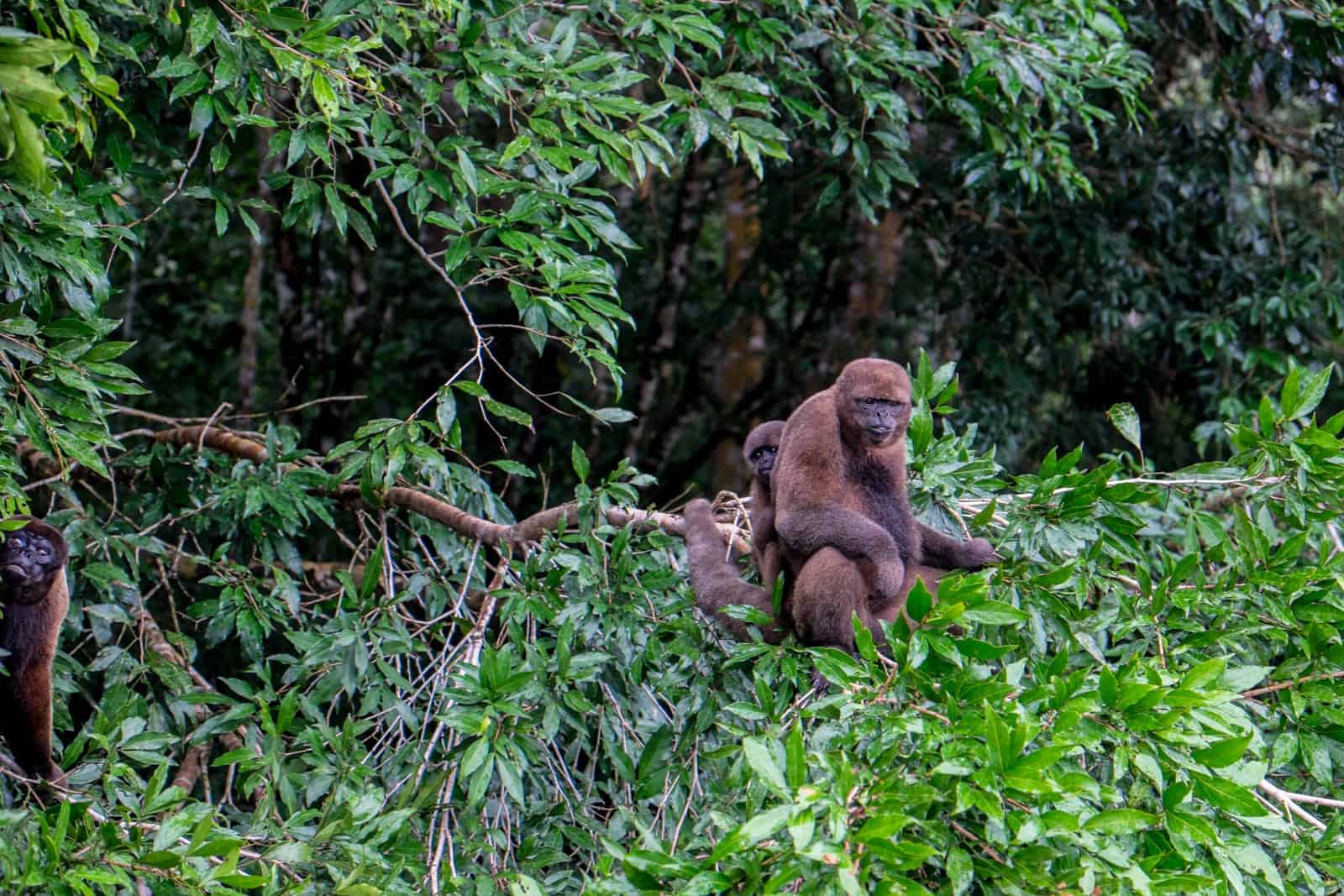
Monkeys in the Ecuador Amazon Rainforest.
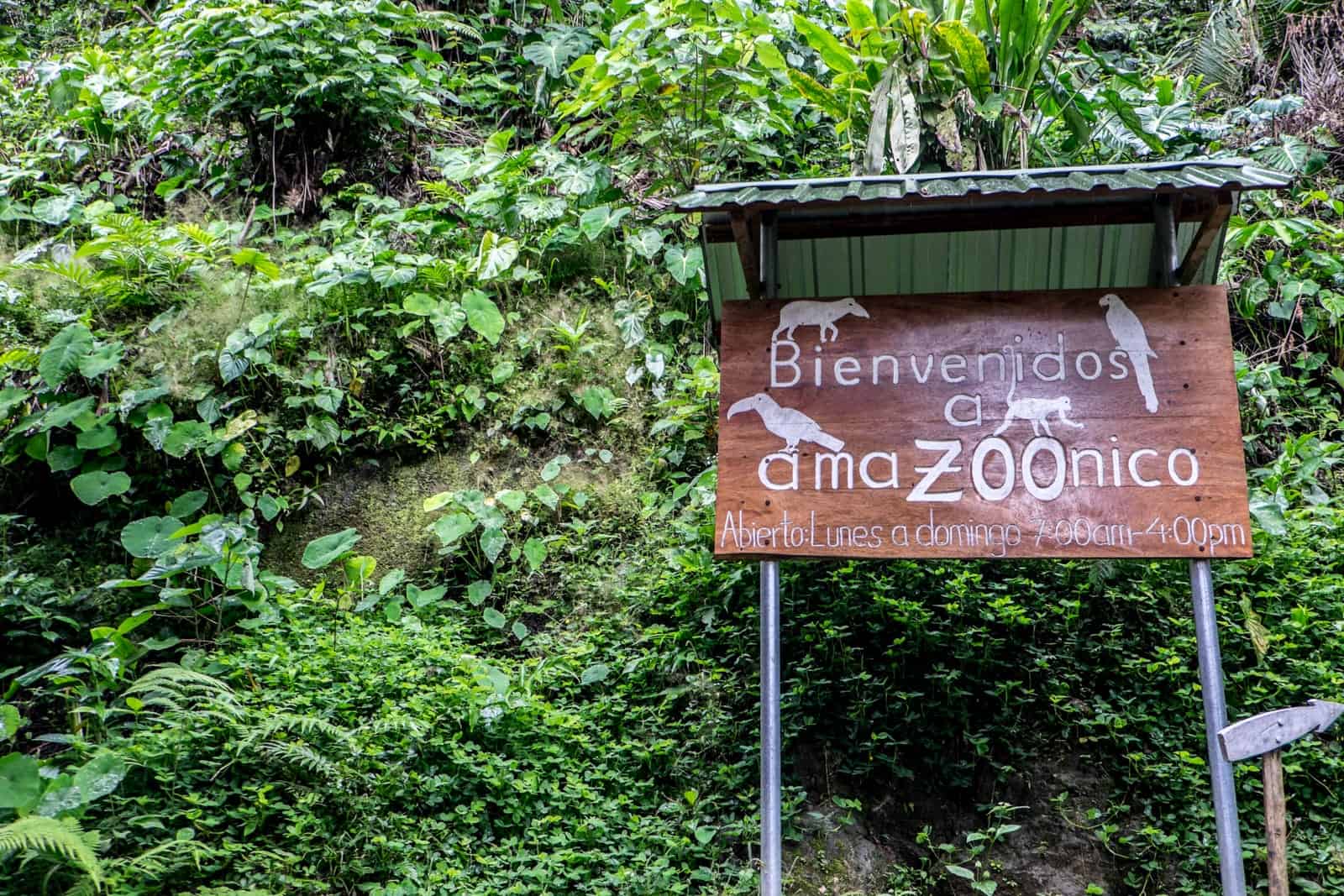
Entering the Animal Rehabilitation Centre.
The animal care centre, one of the core projects G Adventures supports, has been in operation for 25 years, helping to rehabilitate over 3,000 animals and releasing 1,500. Therefore visiting is a core part of the Ecuador Amazon trip itinerary to learn about animal welfare.
Many animals are unable to be released due to the fact they simply wouldn’t survive. Most of these animals were once taken as pets, and when domesticated often get depressed and die or attack humans. Others were captured and abused, hunted for meat and skin or Illegal trafficking.
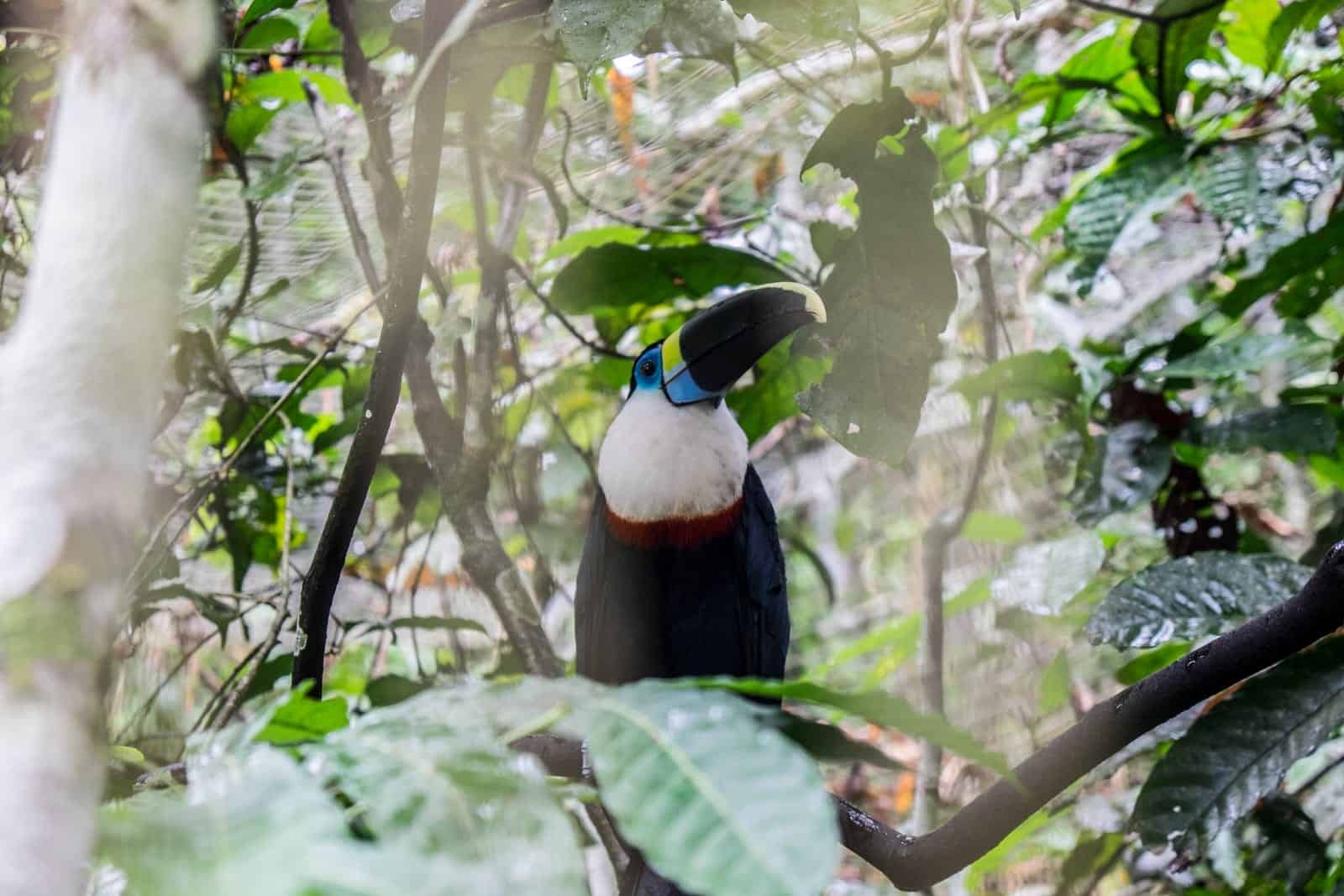
Wildlife rehabilitation in the Ecuador Rainforest.
Walking through jungle trails and often drenched in the rain this forest is known for, this is the opportunity to get up close to some of the region’s wildlife, both rare and often hidden.
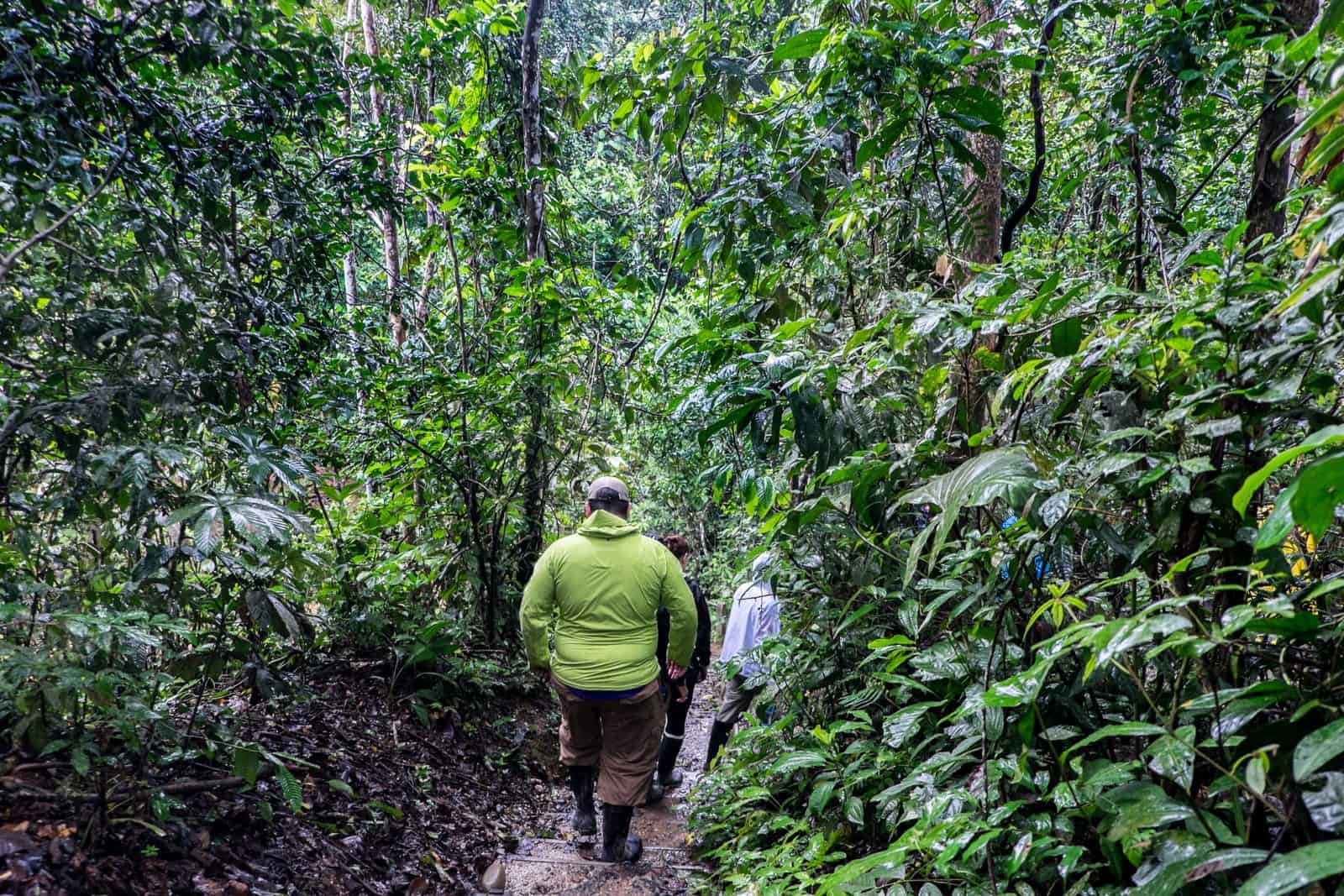
The Ecuador Amazon Rainforest has the most diverse ecosystem of all countries.
There’s no touching of the animals, nor any close contact with the enclosures, both due to the fact that they are rehabilitated to as wild a condition as possible and also not to be in contact with creams and perfumes from humans which can harm them. There’s no interaction with sound, especially with the parrots. Any animals that are roaming free outside of protective enclosures are never handled, as it is paramount not to humanise them. For example, if one monkey thinks humans are nice and then comes across a hunter, they will think the hunter is also nice.
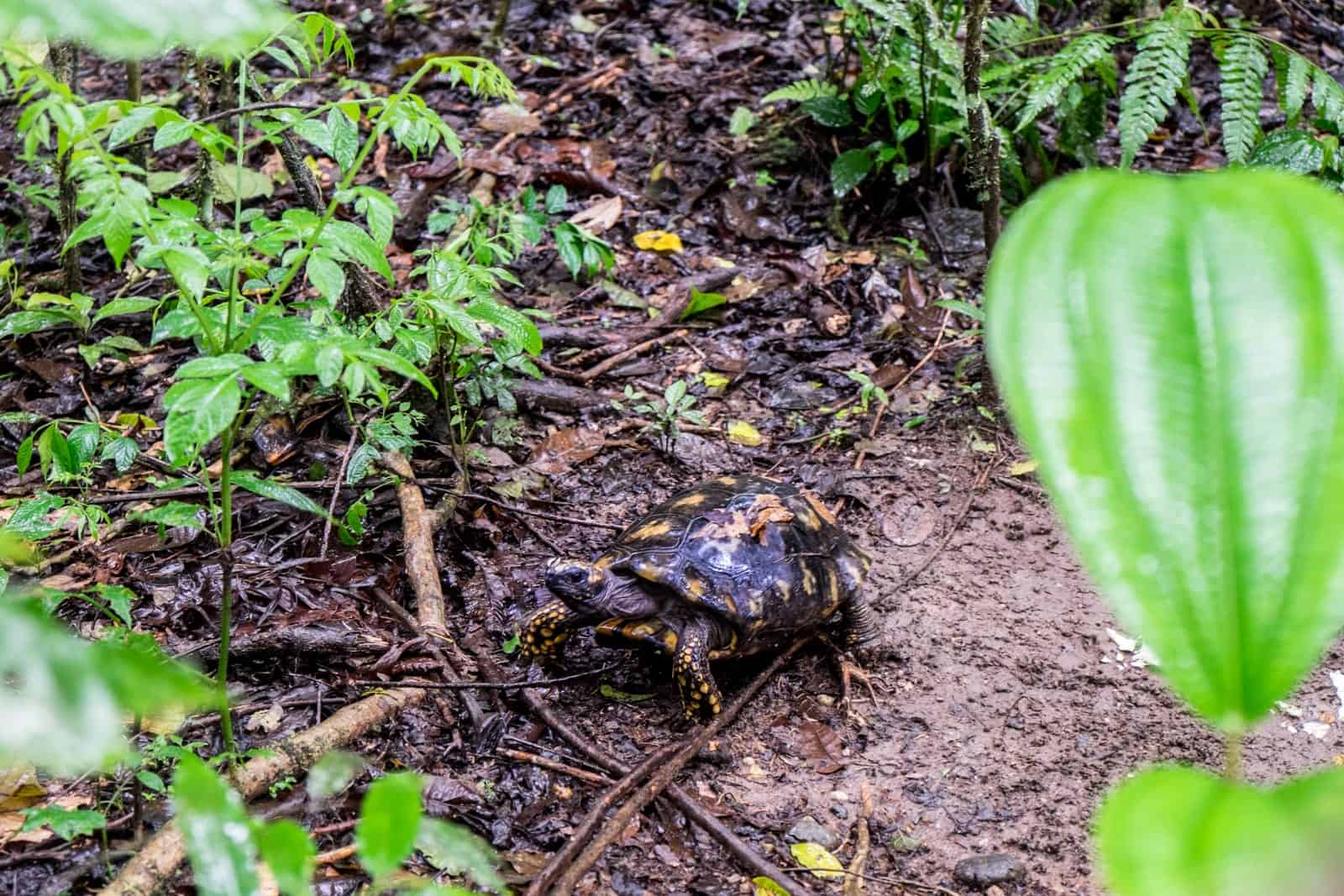
Amazon tortoise.
Ecuador is one of the countries actively protecting the jungle of the Amazon. This animal rehabilitation centre is just one part of that, with other laws being set in place to protect other aspects of the rainforest including confiscated land and jail time if anyone is caught cutting down trees and other forestation.
Despite Ecuador tourism drives bringing in income to the area, there are billions of dollars worth of oil being underneath the Ecuadorian Amazon, especially in Yasuni National Park and Biosphere Reserve. There is an ongoing debate about future drilling and how this will affect the Rainforest and its future preservation.
Tips for an Amazon Adventure
Even if you’re a seasoned traveller seeking a new adventure or new to this kind of offbeat destination, Amazon travel requires some planning. Preparing for a trip to the Amazon might bring images of Indiana Jones and other movie characters, but the reality is much simpler, as these tips on accessibility, difficulty and preparation show. However, there are plenty of options for every traveller and services to accommodate you comfortably, while still feeling unique, remote and in touch with nature.
When to Visit the Ecuadorian Amazon Rainforest
While the best time to visit Ecuador is between the dry season of June-September, the weather in Ecuador’s Amazon is mostly the same during the whole year, where you can expect plenty of rain and high humidity.
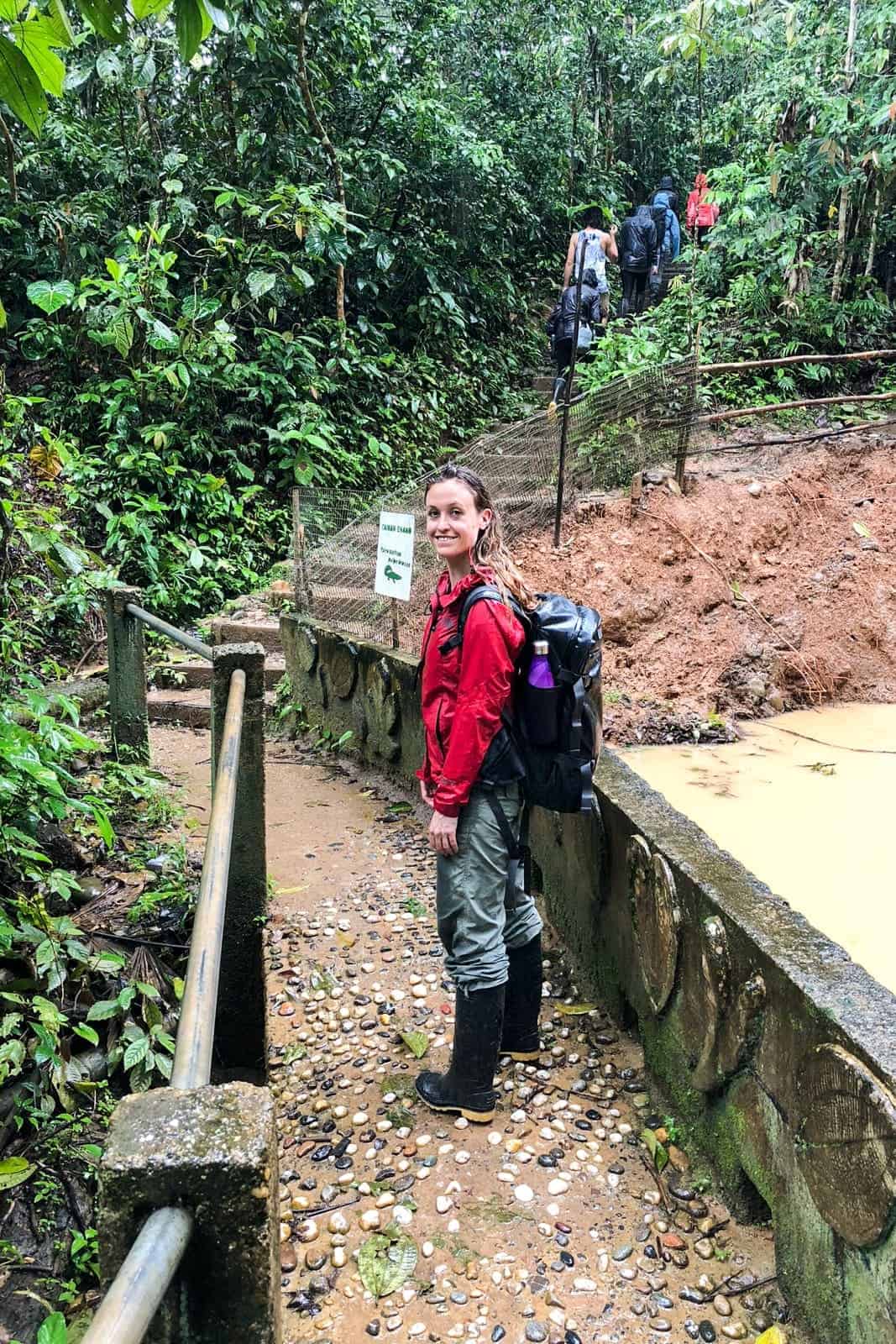
Prepare for the wet weather in the Ecuadorian Amazon.
Local guides explain that both the dry and rainy seasons (dry meaning a little less rain, rather than no rain at all!) have their particular benefits, as you might get to see different animals in each season or sight rare flowers that only bloom during a given season.
Although thousands of tourists visit this area every year, you can expect little to no traffic of tourists in the area. Amazon lodges, experiences, and trips are all seemingly very spread out.
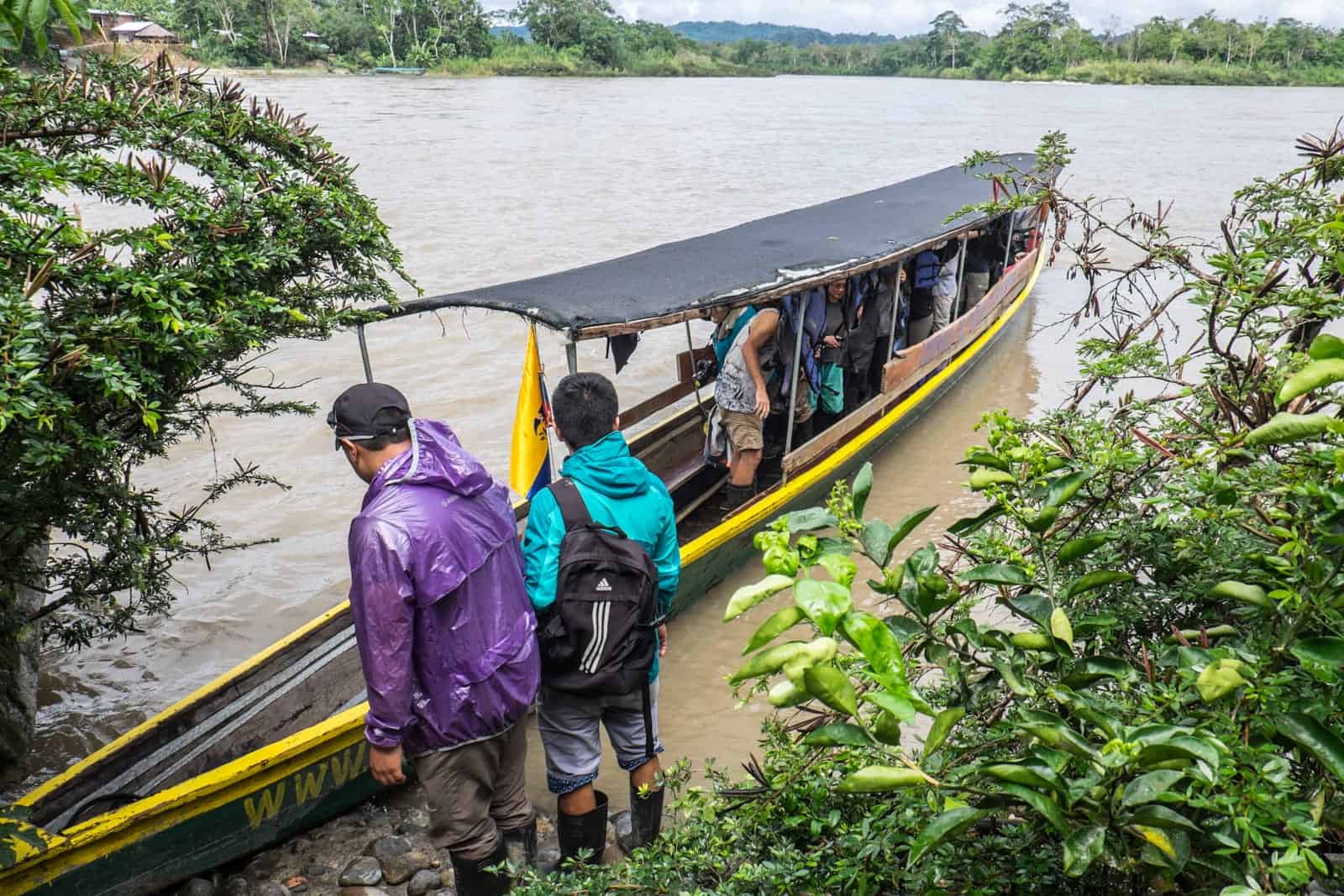
Longboats are the main form of transportation to Amazon destinations.
How to Get to the Ecuador Amazon?
Unlike other countries, access to the Amazon from Ecuador is straightforward. Take a flight directly to the capital of Quito, and in only five hours by bus or van, you can get to the border of the rainforest at the city of Tena. There are actually six cities based here: Coca, Lago Agrio, Orellana, Papallacta, Puyo and Tena, but Tena is seen as the main and most used gateway.
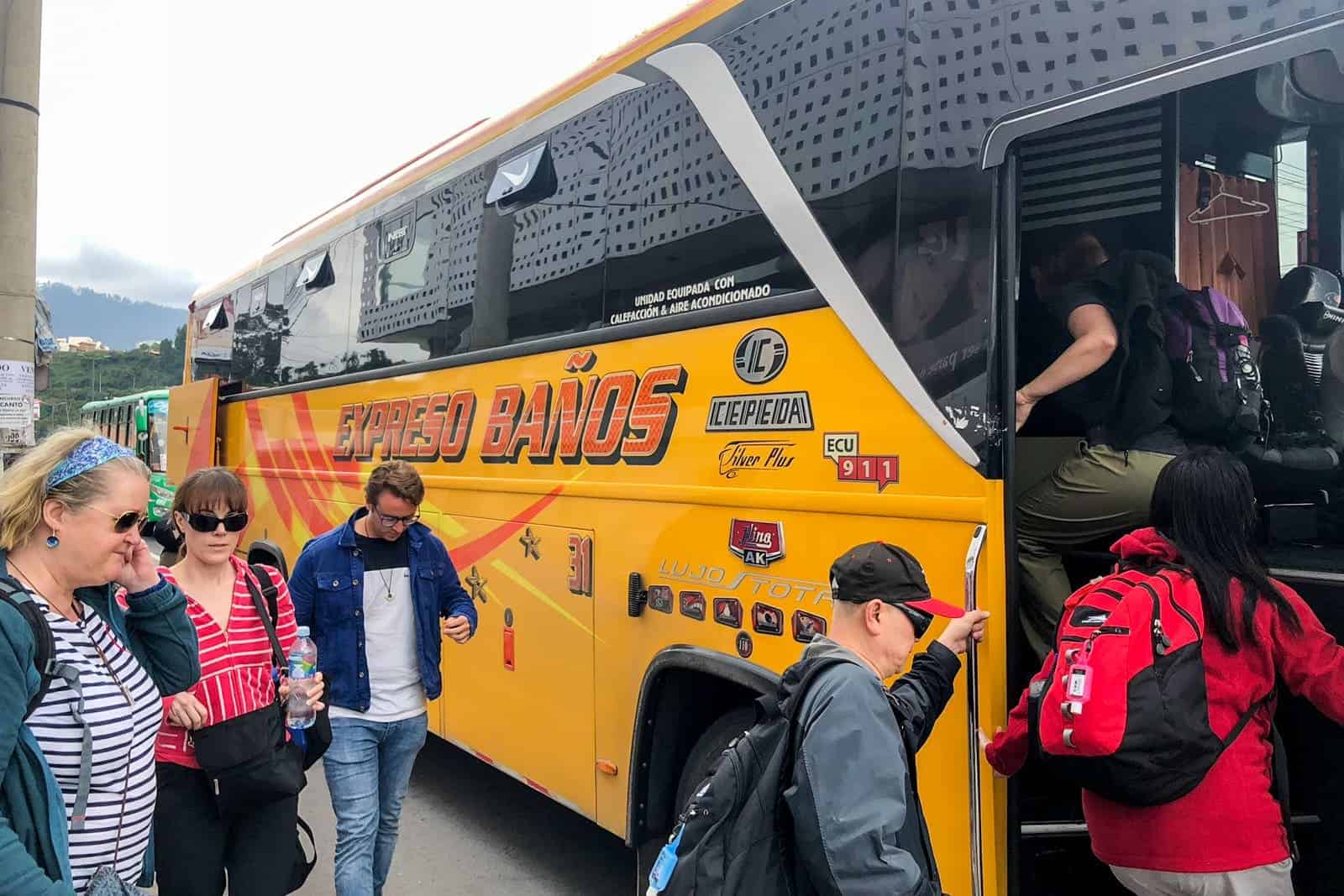
The Expreso Baños local bus from Quito to Tena.
You can get to Tena by public buses that go as cheap as $6 per trip, but you might miss some of the natural landscapes that decorate the trip. If you can find an affordable taxi or van to travel you or your group to Tena, you might be able to stop to take pictures and enjoy the beautiful sights between Quito and Tena.
If you’d like to go deep into the Yasuní Biosphere Reserve, you can also take a domestic flight from Quito to Francisco de Orellana Airport in Coca to stay in an eco-lodge and stay right in the middle of the jungle.
My local bus ticket to Tena and the transport beyond were all included in my Amazon trip.
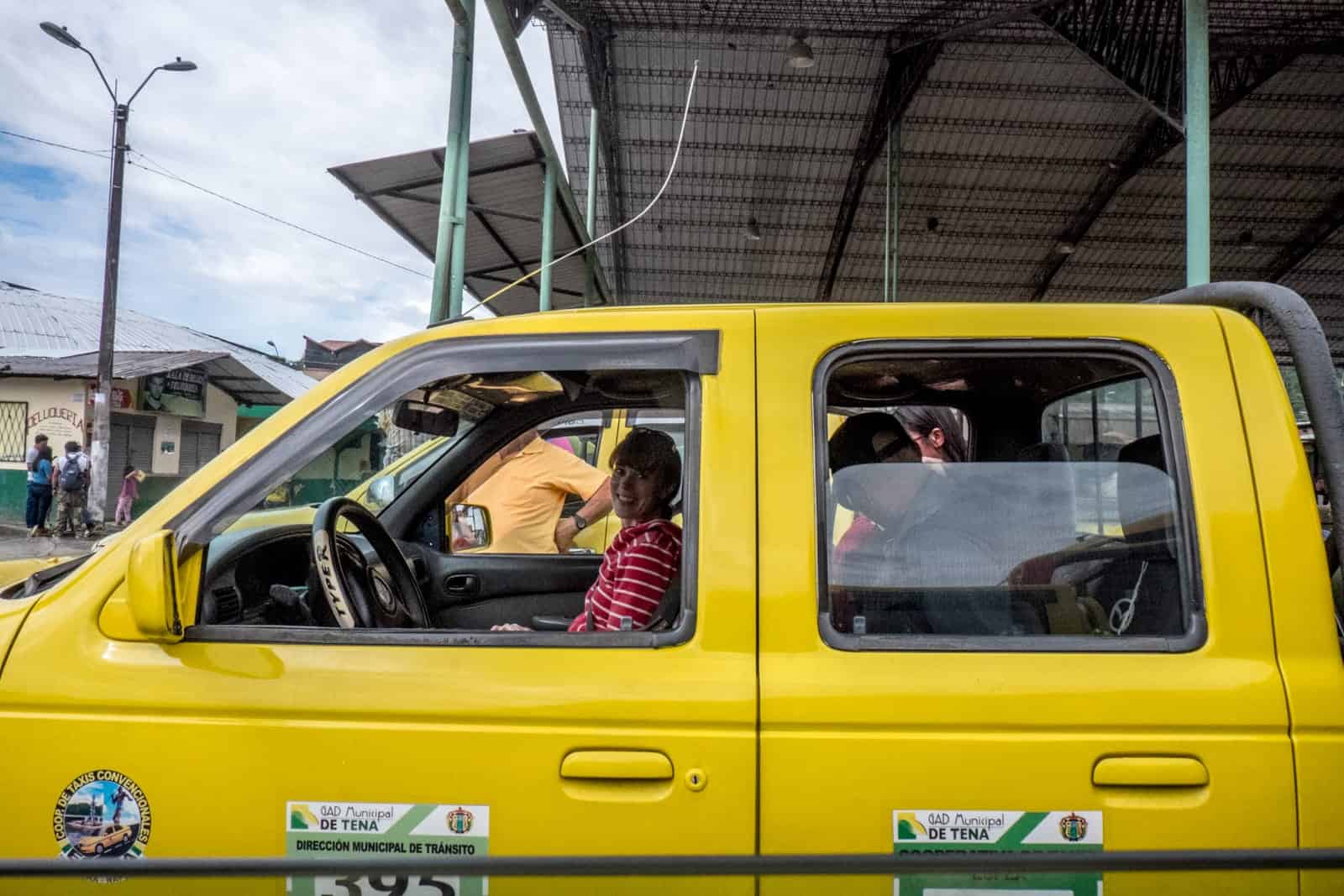
A Taxi in Tena will get you into the heart of Amazon Rainforest.
Is Travel to the Amazon Safe?
It is not at all advised to travel alone in the Amazon since this is unknown territory that is easy to get lost in. There is a reason so many thousands of travellers come here in small groups and with a local guide.
Do not embark on long jungle hikes alone since the majority of trails are not clearly marked. If you want to go on an extra excursion, ask the local you are staying with who will most likely oblige and be proud to show you more of their home.
Don’t venture anywhere at night without a flashlight. We saw some unwelcome visitors in the form of giant spiders and a scorpion in our bathroom.
Even if travelling solo in the Amazon, it is best to stay at a registered lodge with adequate set-up for visitors, so that people know where you are.
Is it Difficult to Travel in the Amazon?
The difficulty of your journey to the Amazon depends entirely on your preference and planning. If you’re going to participate in sports activities or trekking through the jungle, the trip might require plenty of stamina and might prove difficult for the inexperienced.
However, if you’re going to stick to your guide and follow your tour as planned, you’ll find that although it can be tiring due to the weather and long trips, the journey is accessible and achievable by everyone.
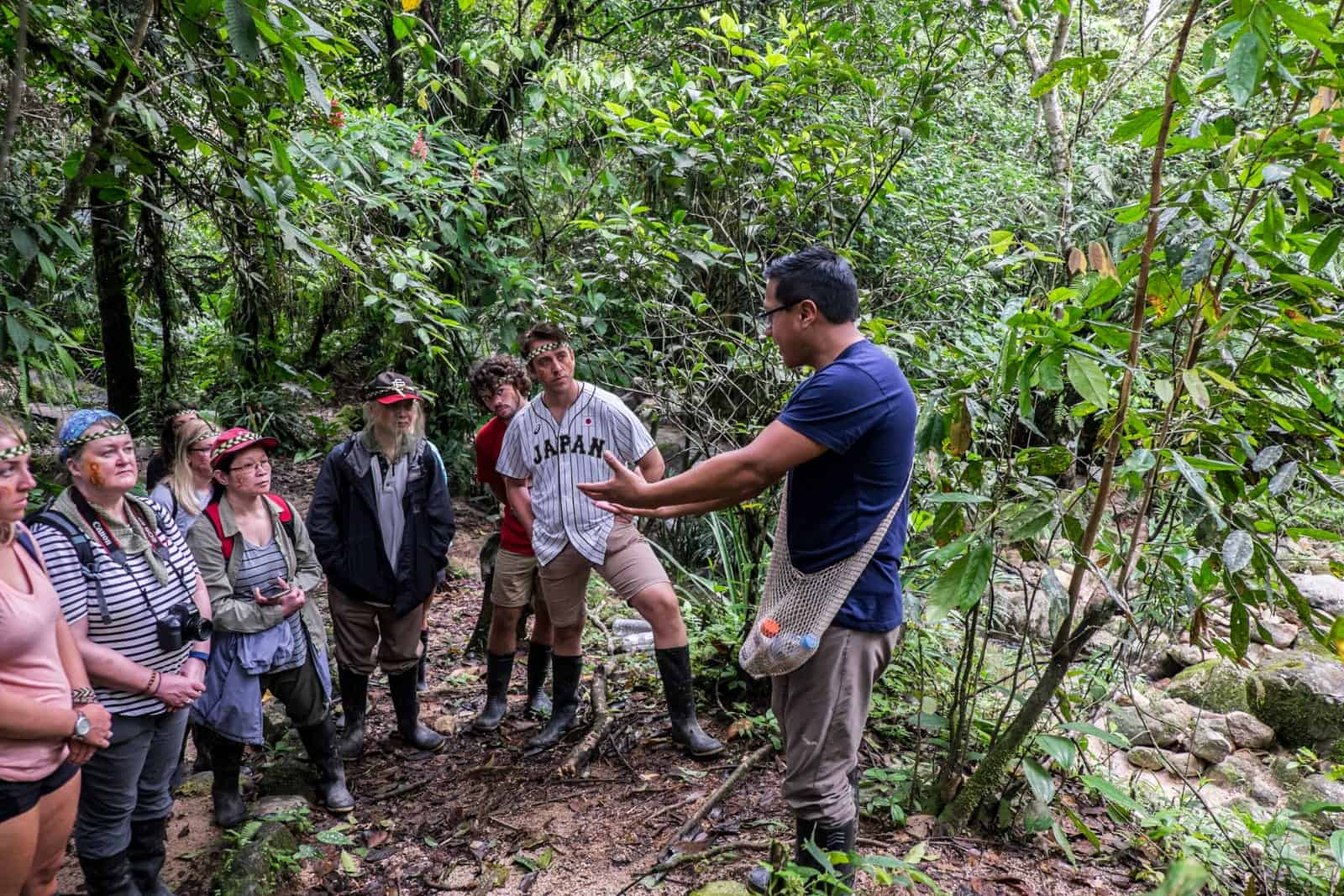
How difficult is it to travel to the Ecuador Amazon?
Do I need Vaccinations for Amazon Travel?
The Amazon rainforest is not a destination without risks so you must prepare accordingly. Although the cases of yellow fever, dengue, and other diseases have lowered in recent years, you must always consult with your doctor about the vaccinations recommended and required to travel to Ecuador.
According to the CDC (Centre for Disease Control and Prevention), it is recommended to get your Hepatitis A and Typhoid vaccinations (on top of your routine MMR) as there is a risk of these via contaminated food and water.
Proof of a yellow vaccine vaccination is regularly listed as one of the Ecuador Entry Requirements. Even though I wasn’t asked for it upon arrival you may well be. Yellow Fever is also recommended if you are travelling to the Andes Mountains in areas of high elevation.
To avoid any chance of catching a disease brought about by insects, such as mosquitoes, you might want to stock up on insect repellant creams or lotions. I took anti-mosquito shower gel and repellent with me, alongside my everyday medications, and painkillers.
The tap water in the Ecuador Amazon is not safe to drink, and it is recommended to also not drinks from the rivers and streams, which may contain waterborne diseases and parasites. Purified water will likely to provided to you by your hosts, but just in case bring water purification tablets with you or an instant purifier filter like a Lifestraw, a UV light SteriPen water purifier or a reusable filter water bottle like Water-to-Go (Use the code BECKI20 at checkout for a 20% discount).
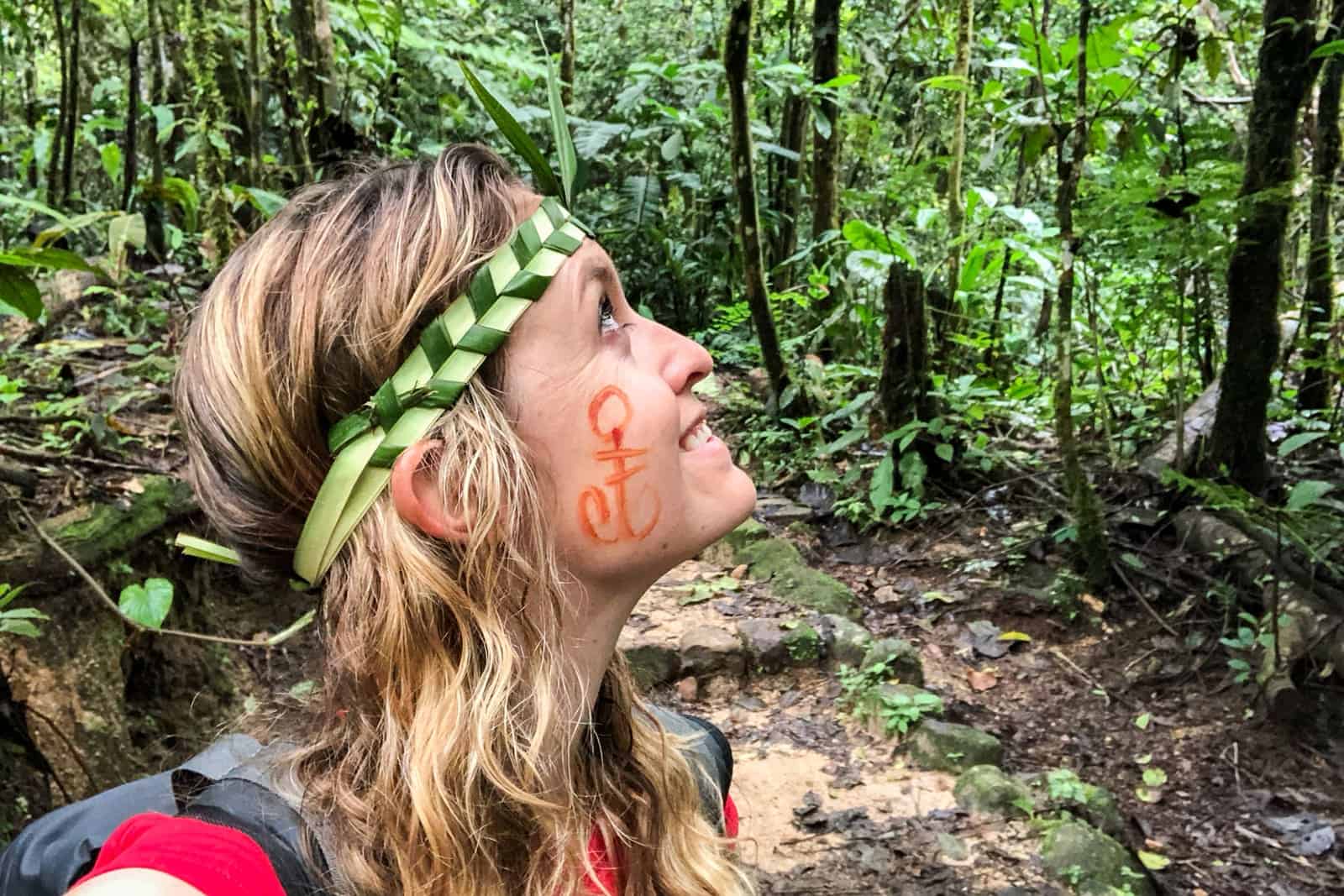
Heading to the Amazon jungle? Be prepared.
What to Pack for Travel to the Ecuadorian Amazon
Packing for the Amazon isn’t so difficult, but you’ll need layers for the changes in temperature, light pants and long sleeve shirts of light fabrics for cover in the jungle, lighter clothing for the hot and humid parts of the day and waterproof clothing layers for when those sunny days instantly turn into the frequent rain where the forest gets its name.
With my host family, mosquito nets were provided for each bed in our rustic accommodation and rubber boots were mandatory for walks in more dense areas of the jungle, with enough pairs for every member of the group.
- A pair of light khaki green trousers, that can be rolled up when humid and be long enough to tuck into the rubber boots provided on jungle walks.
- A pair of black leggings / comfy yoga pants / lounge pants for the evenings, and also worn while my daytime trousers were drying.
- 2 x t-shirts and 2 x tank tops, always with the aim in mind to have one to wear while the other is drying out.
- 1 jumper (I had a traditional Ecuadorian wool style purchased in Quito) especially when the temperature dropped at night.
- A light waterproof jacket (it’s not incredibly cold when it rains).
- Swimwear (I had a green leaves print bikini, which fit the surroundings!) for spring and lagoon swims and water rafting.
- A pair of sports shoes (I’m a Vivobarefoot fan) for excursions that were not jungle treks.
- A pair of flip-flops or sandals for use in the afternoons when relaxing, in the evening and/or in the shower.
- Underwear to last you for one week and a light pair of Pyjama pants.
- Toiletries and a quick dry travel towel as there is nothing available on-site and if one towel is provided, it doesn’t always dry quickly.
- A head torch for the evenings when the lights go out after a certain hour.
- Earplugs if you find it hard to sleep to the sounds of jungle nature. Although if you can get used to it, it’s beautiful.
- A reusable filter water bottle like Water-to-Go (Use code: BECKI20 at checkout for a 20% discount). Ideal for when you are out on long walks, small treks and day trips. Don’t take and leave plastic!
- A full portable charger (Anker is my go-to power brand) and spare batteries for your camera, as everyone is usually vying for limited electricity and plug sockets.
However, should you be in need of an emergency item or any amenities, there is a chance to make a trip into Tena on the way back from a day trip, which we did one day to stock up on snacks and any essentials.
Ecuador Amazon Tours – Planning Your Trip
There are a handful of Amazon Rainforest tours from Ecuador and group travel is the primary way in. Often being on an organised trip or in a group often seems taboo, but that’s not true. Not only is it pretty much impossible to find your way around the Ecuador jungle without such small group guidance, without my fellow travellers my time in the Amazon wouldn’t have been the fun, unique, once-in-a-lifetime opportunity it was.
Without G Adventures we wouldn’t have had access to the family we lived with and the experiences they shared with us in their homeland, and to know we were spending our money ethically and it going to the right people and projects.
See booking details for Local Living Ecuador – Amazon Jungle small group tour. It’s a seven day round trip that starts and ends in Quito, with five days based in the Amazon jungle staying with the Quichua family. The price includes accommodation, transport, food and excursions. Our water rafting trip was an optional extra we all choose to do as our final hurrah in this wild adventure.
Groups are kept small and as much as it’s rare to get along with each person on a trip when compacted into a few days and in such a remote place, we did, leaving the Amazon with more than just survival skills and a better understanding of the Amazon people. Don’t be too quick to agree with the notion that being amongst others can ruin the raw experience. More often than you realise, it can actually enhance it.
READ MORE: Solo Travel vs Group Travel
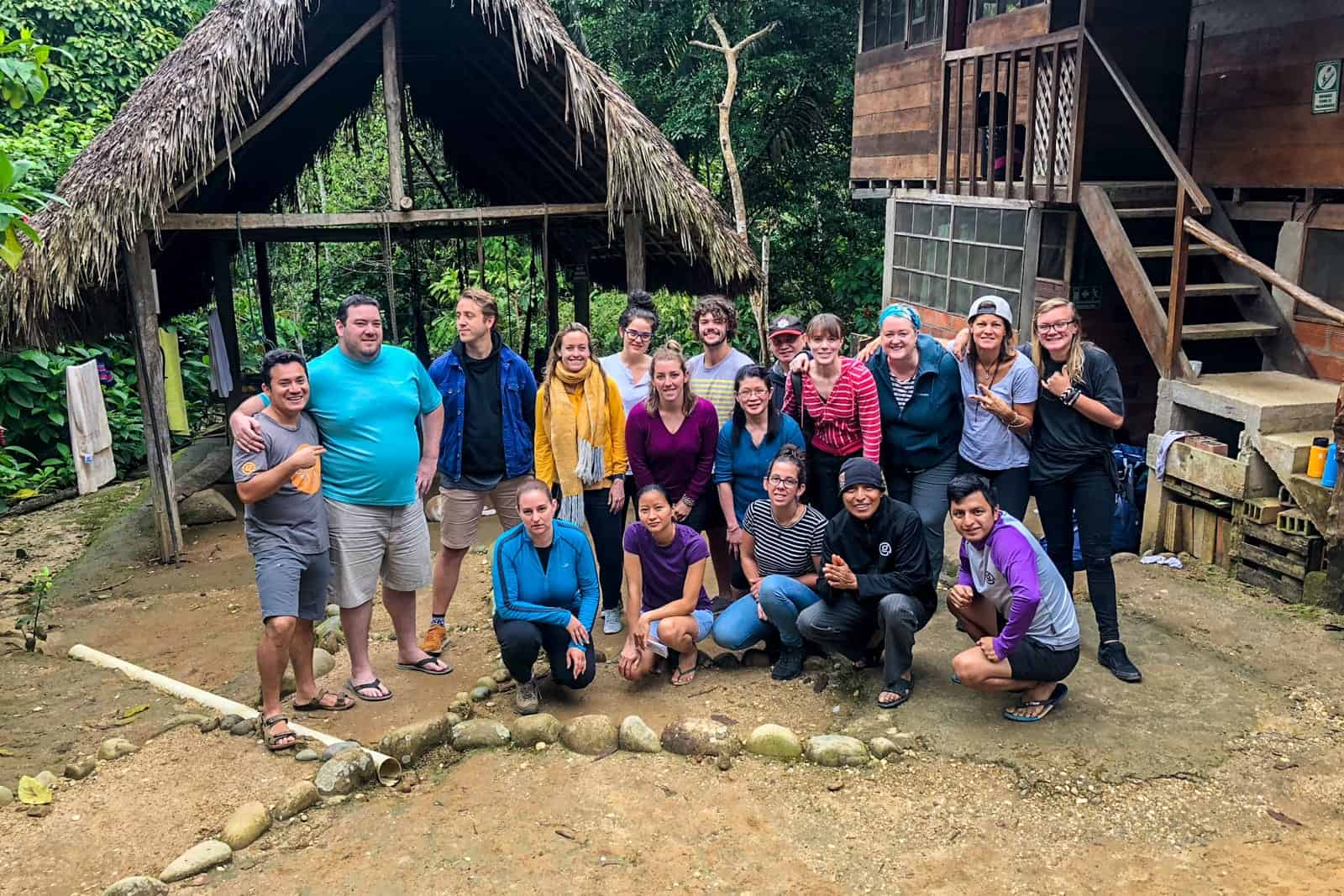
The G Adventures tour group in Ecuador Amazon and a lifetime of memories
My trip was part of a brand partnership with G Adventures to encourage travellers to explore the planet in a meaningful way and to help change people’s lives through travel. All opinions and experiences remain my own.

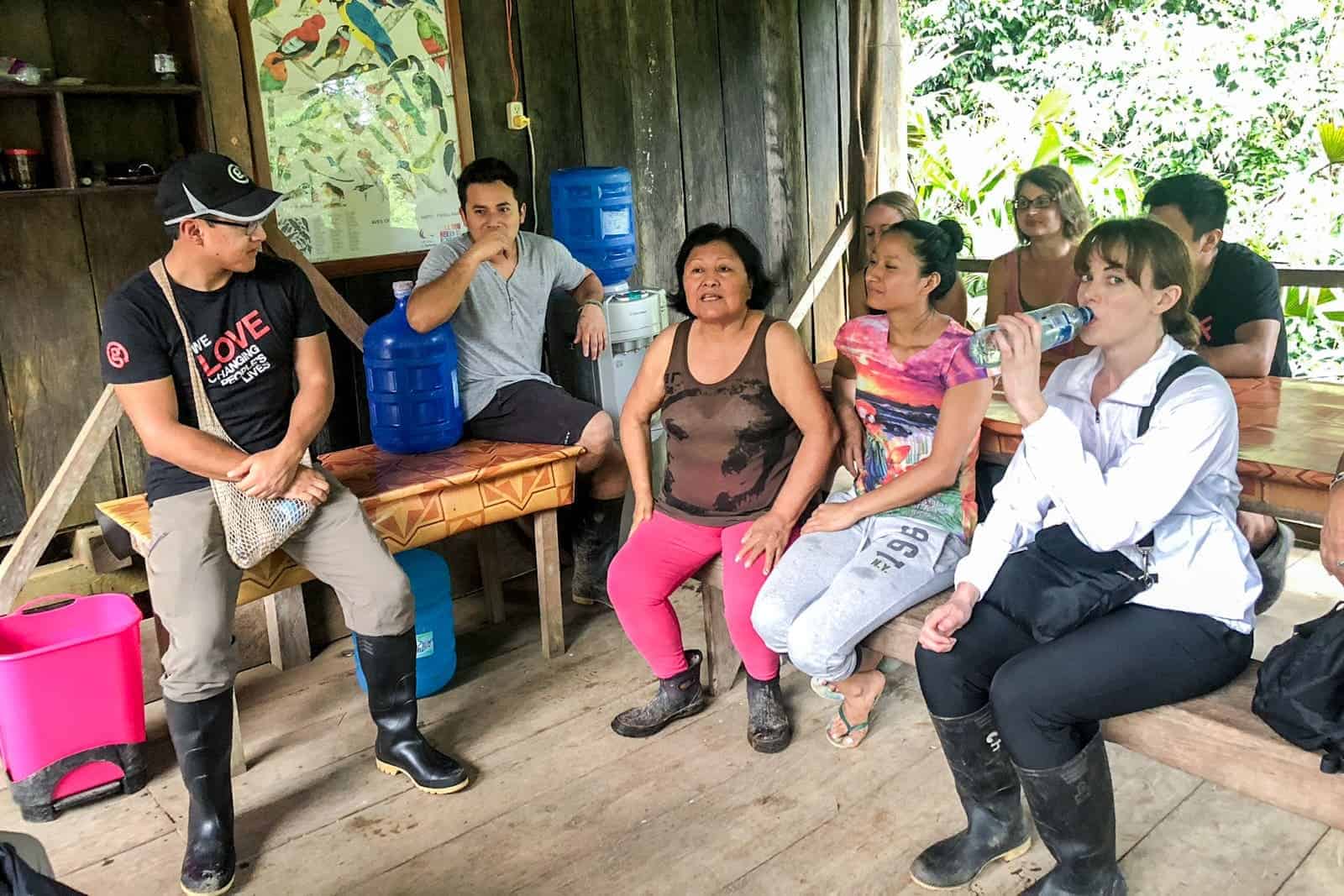
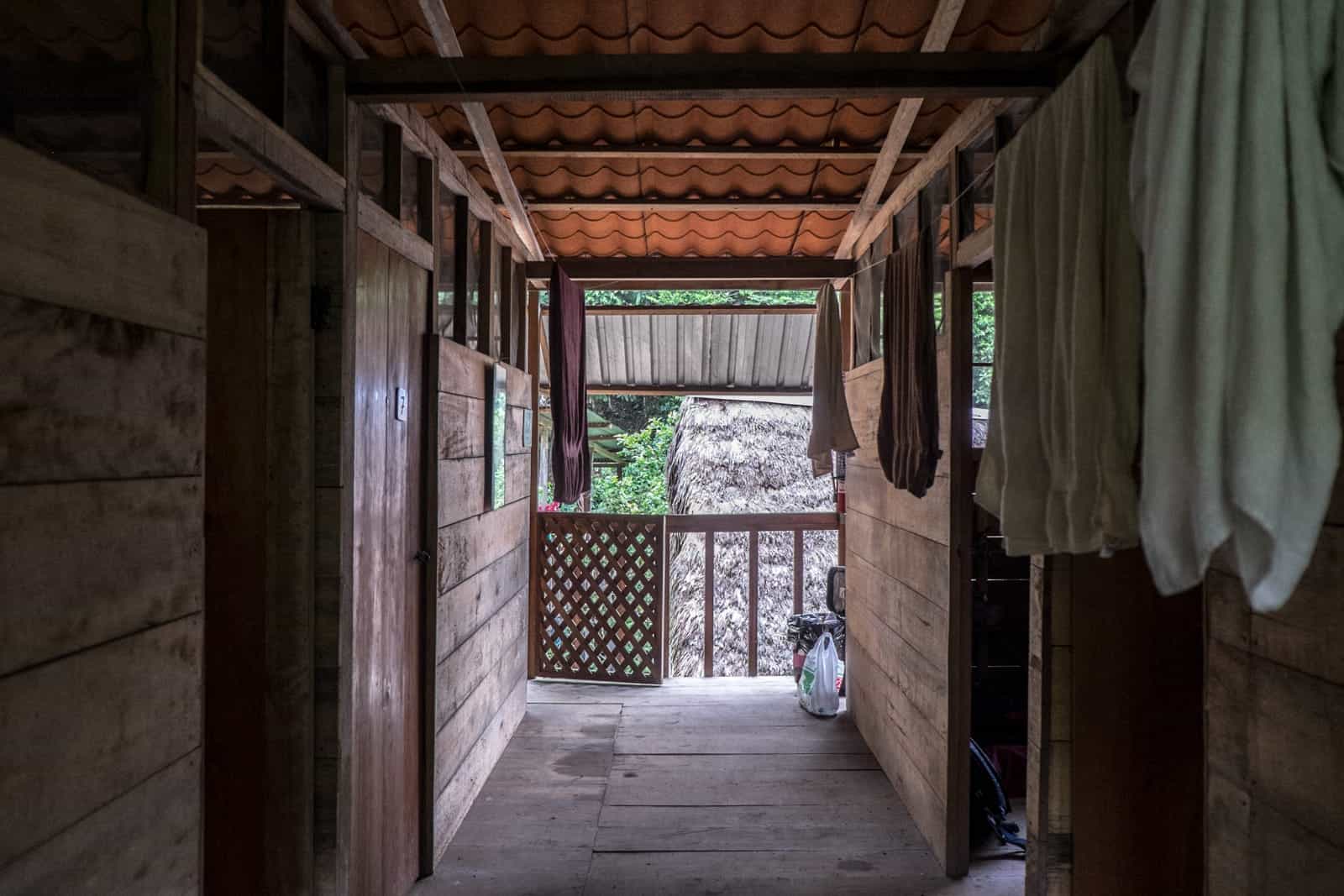
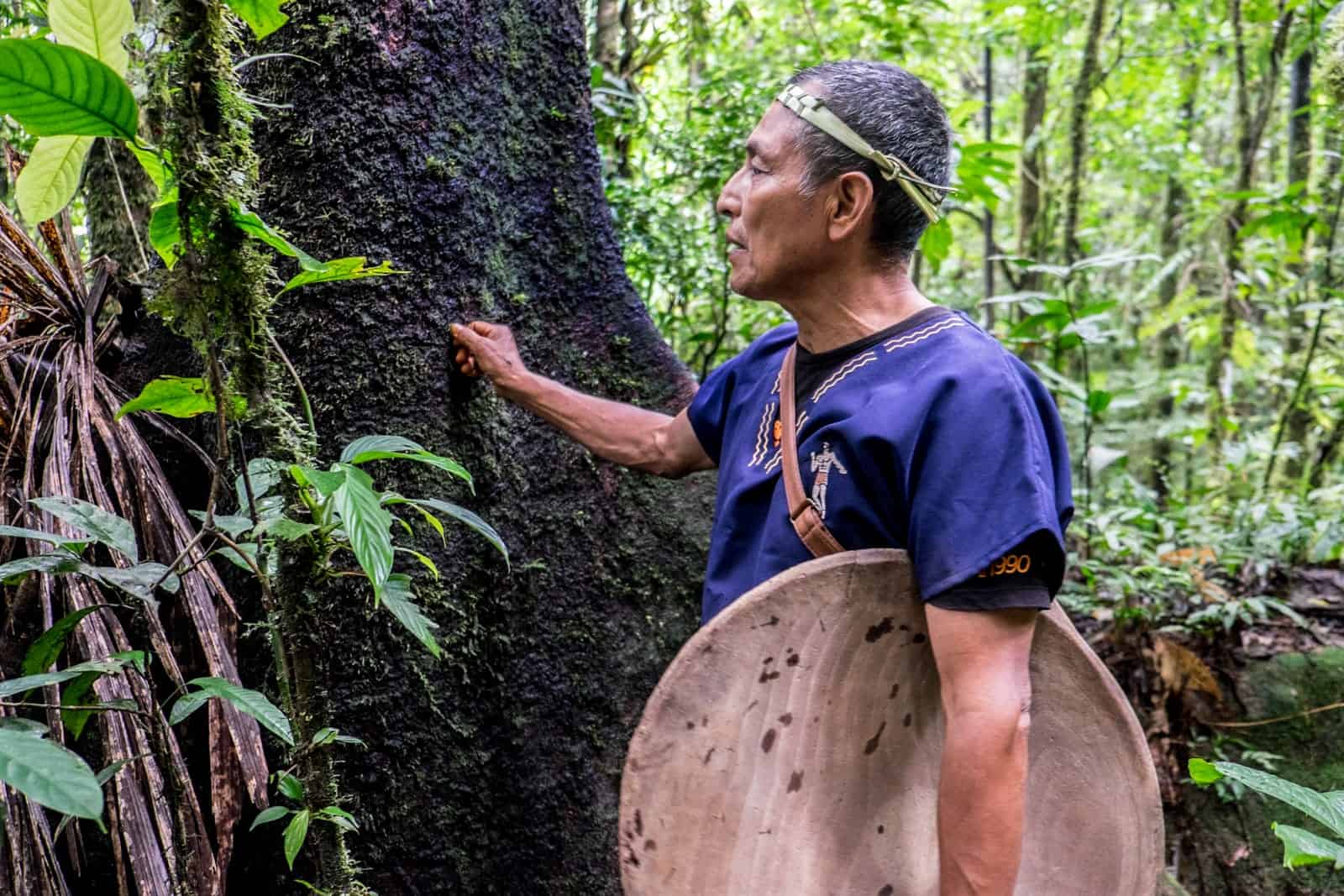
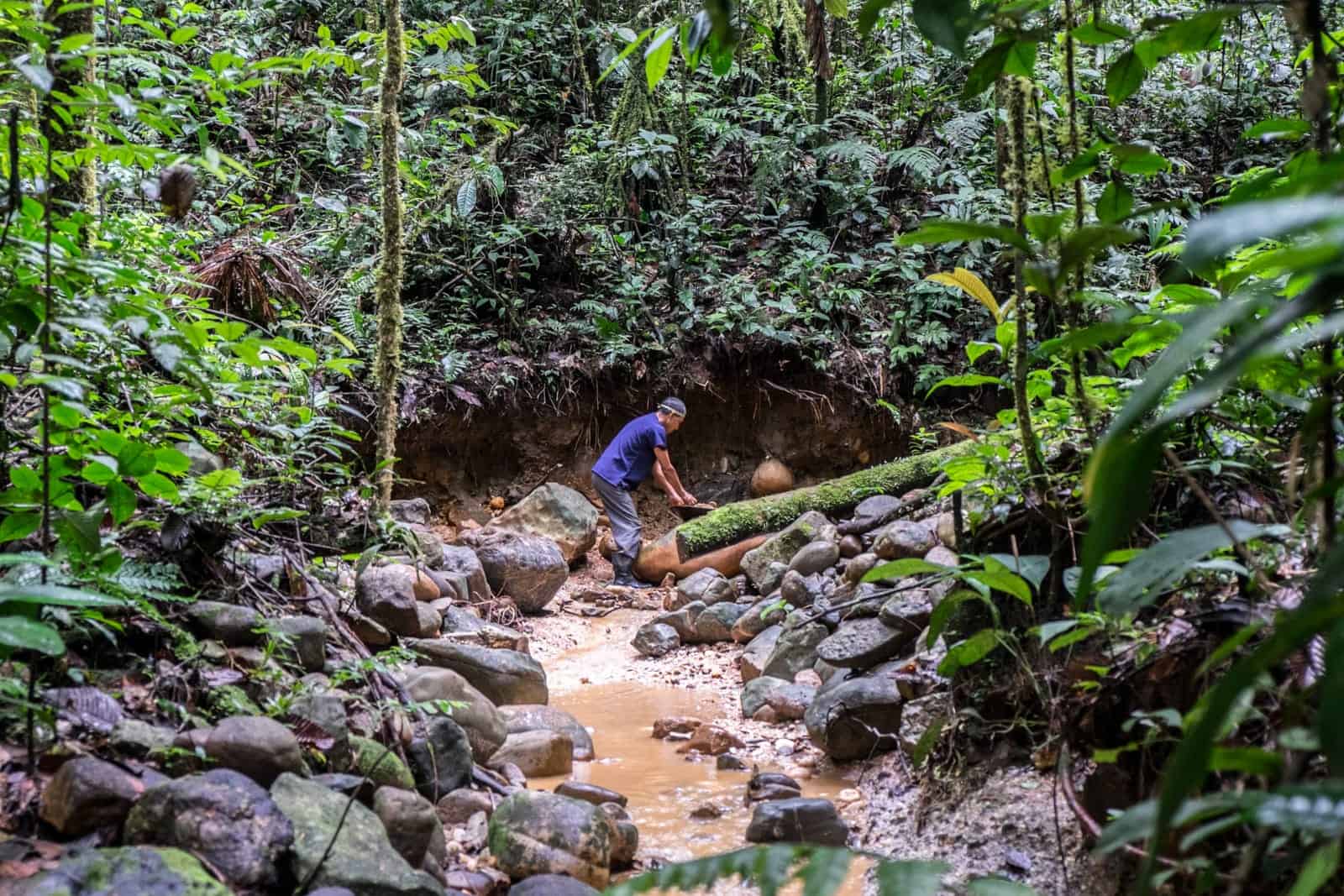
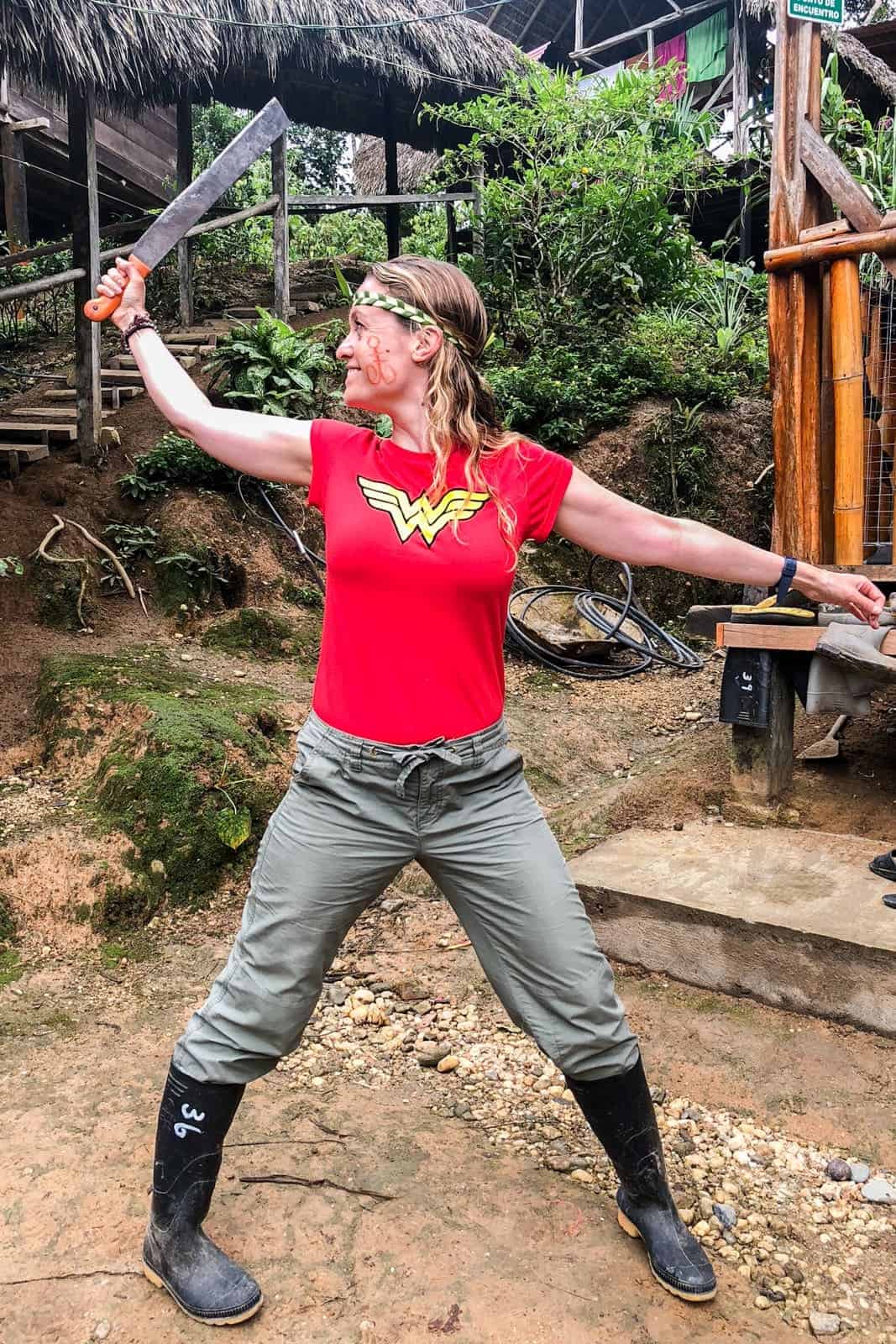
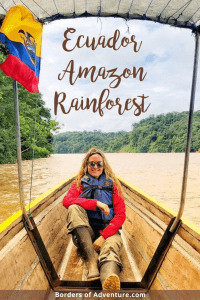

Leave a Reply